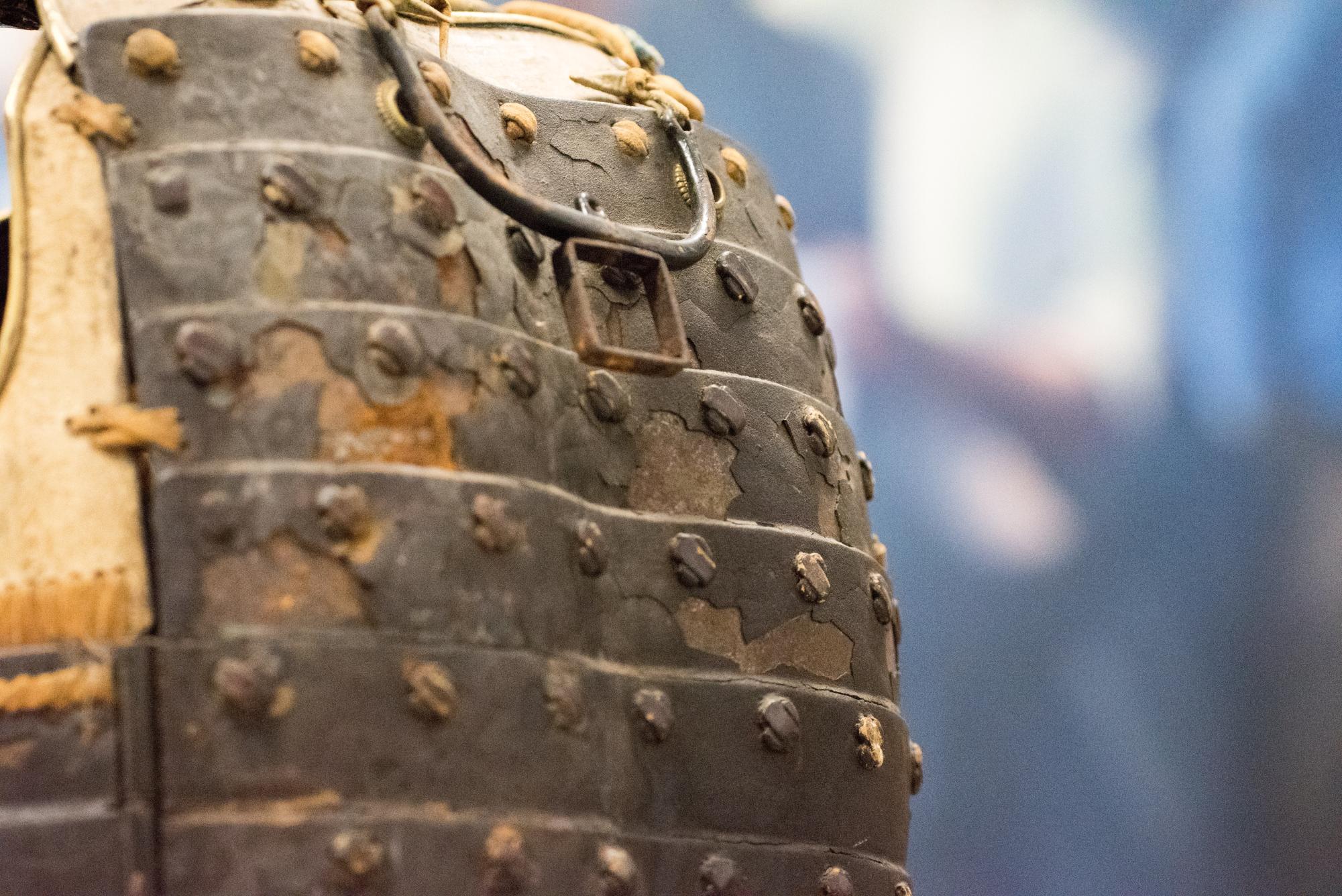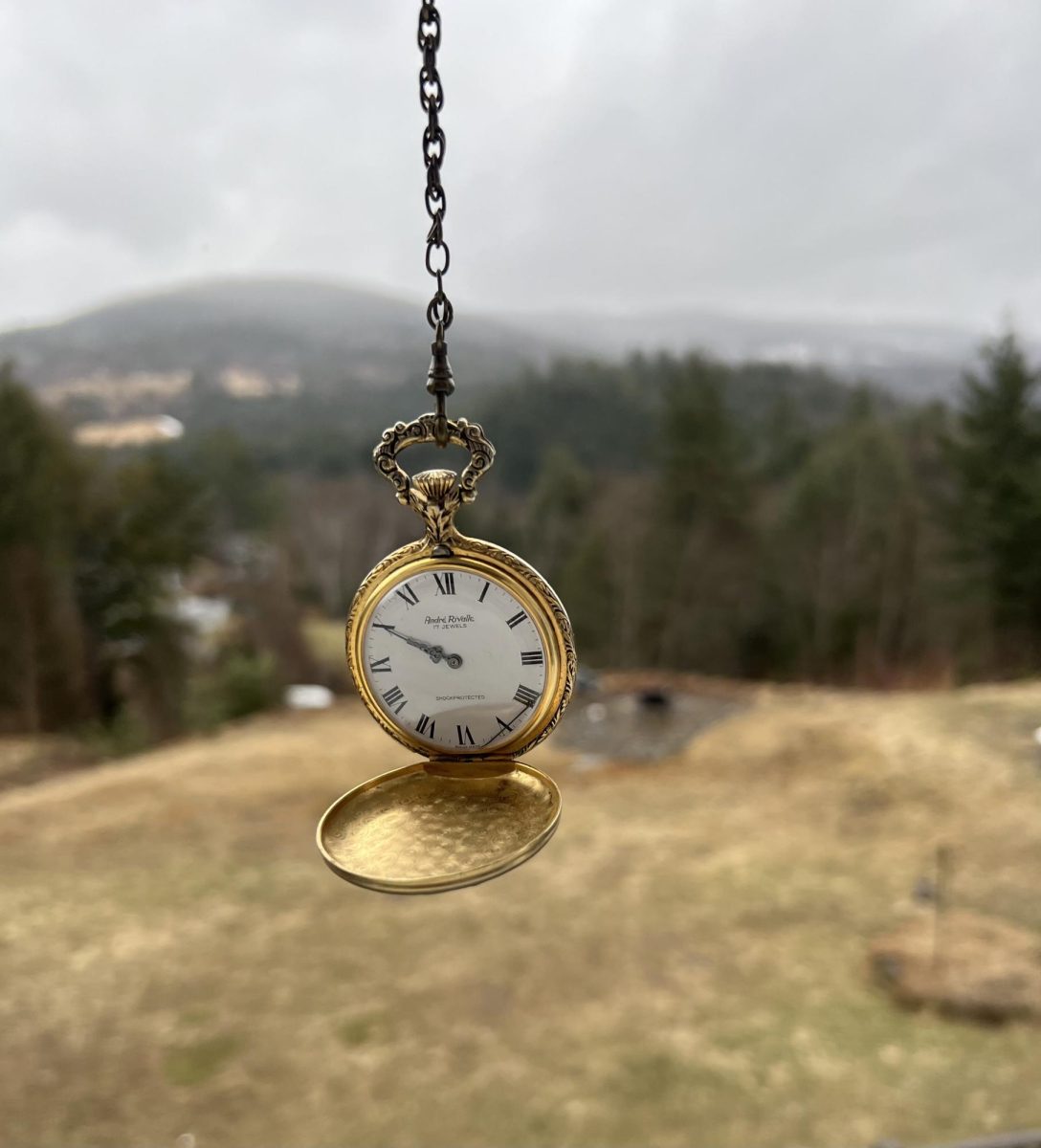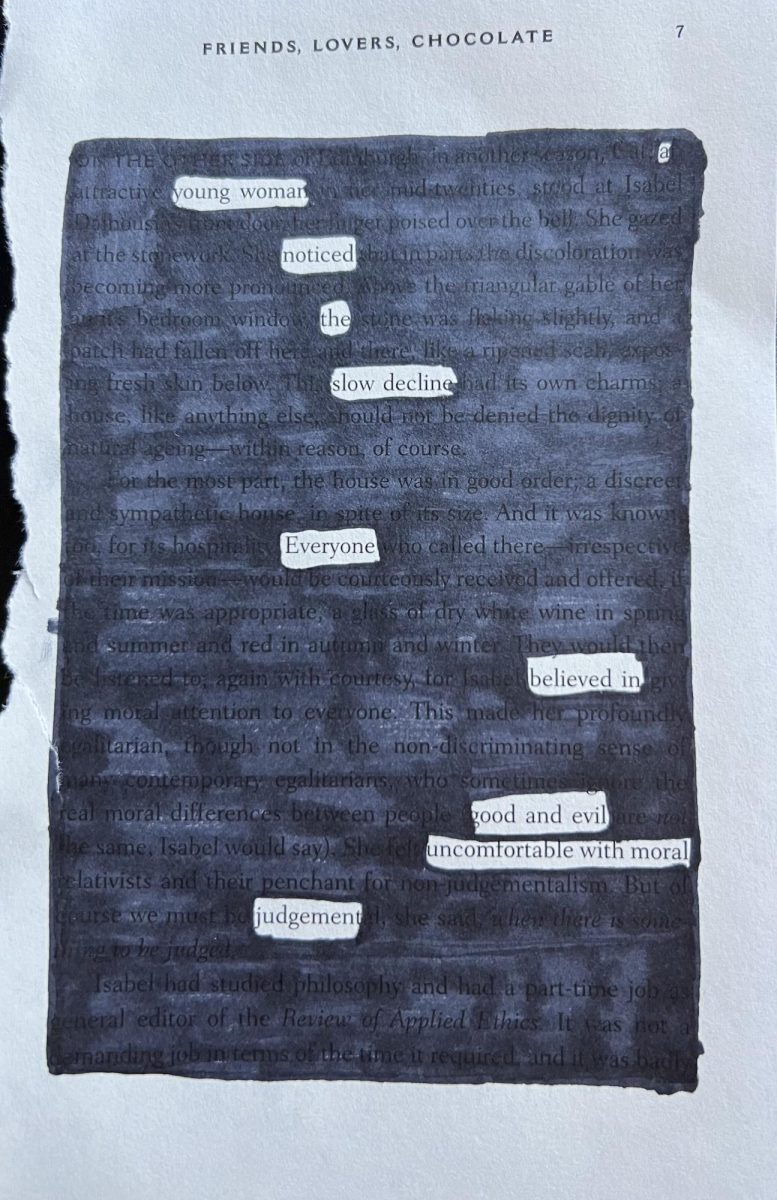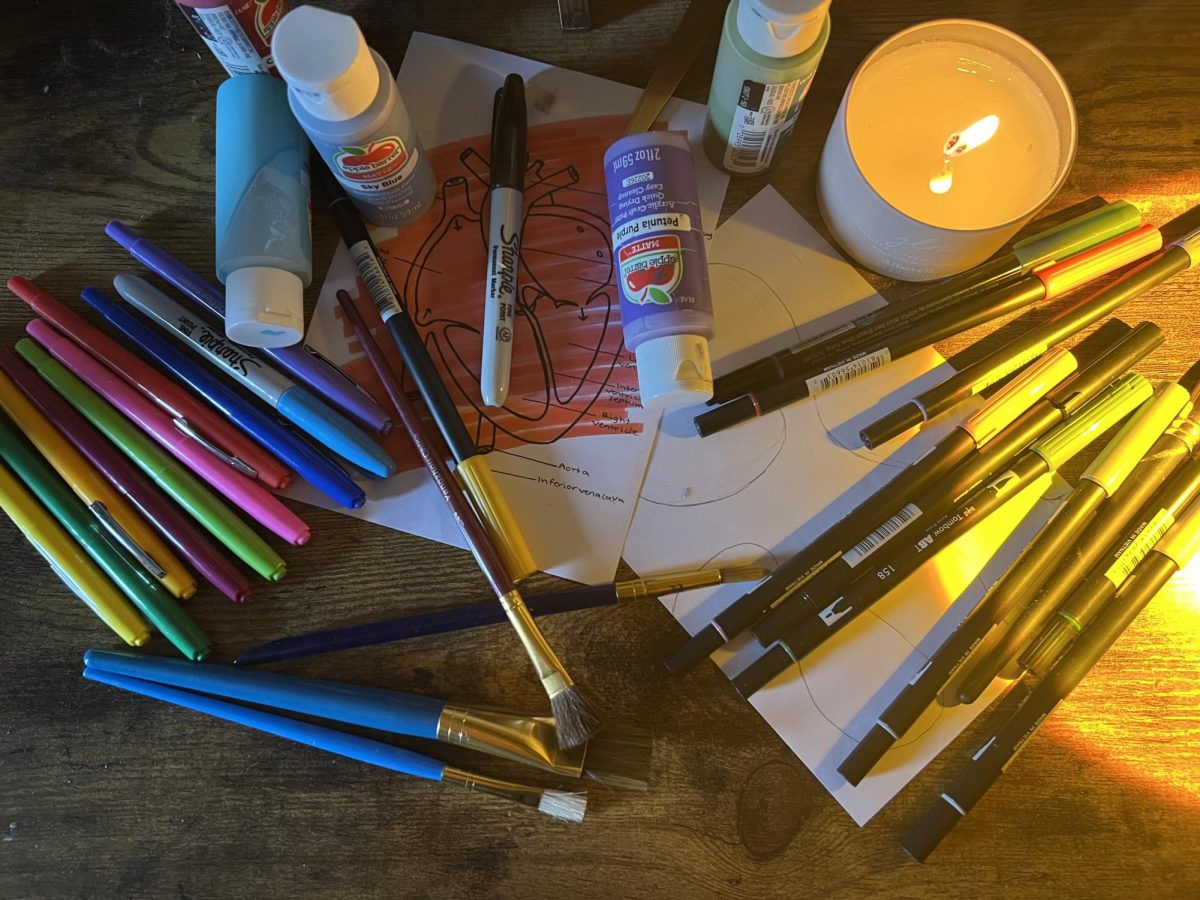Samurai Armor Stories from History of Civilization
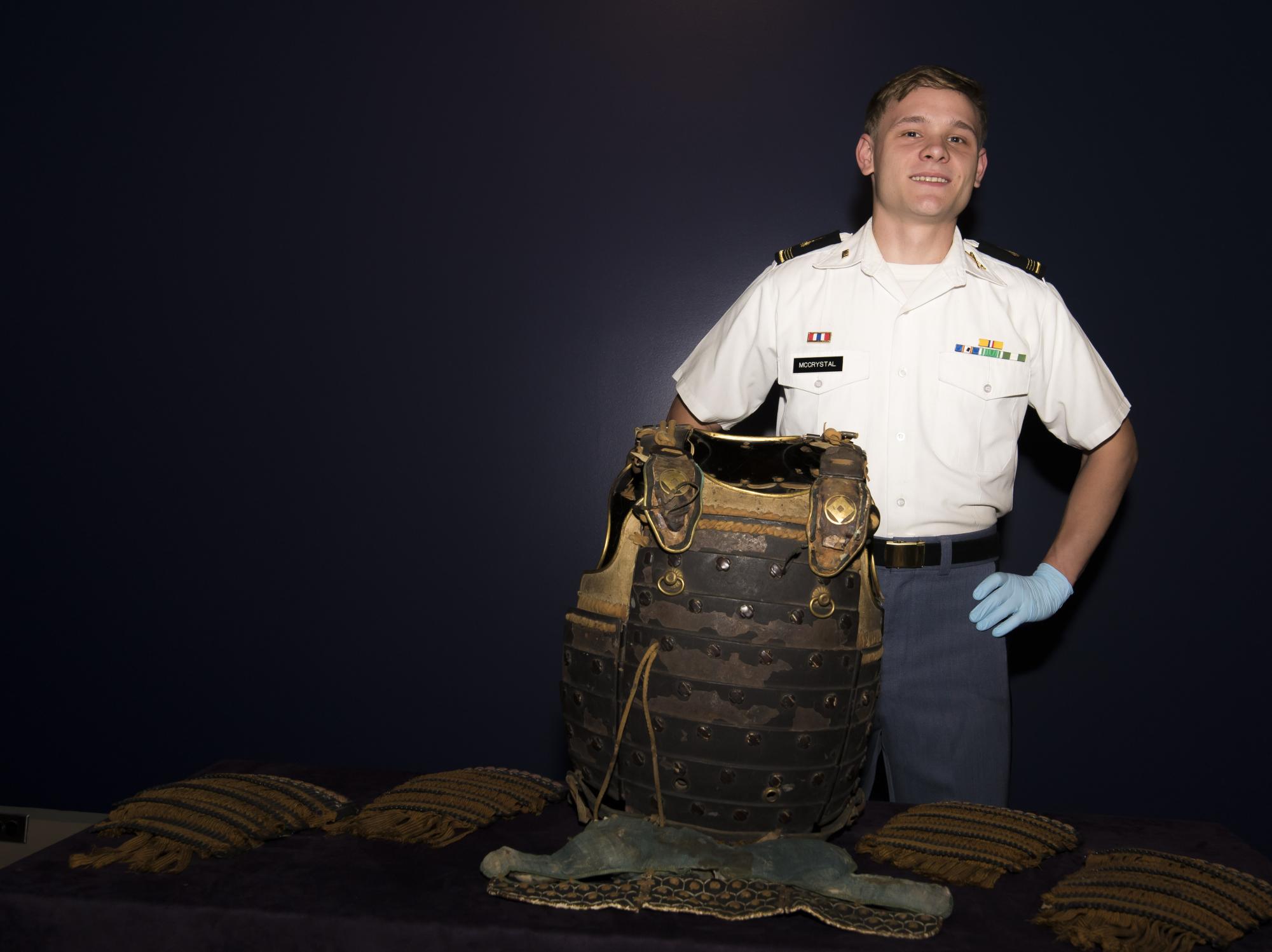
While supporting US forces during the Boxer Rebellion in China in 1900, Col. Richard Coolidge (NU Class of 1863) acquired an ancient clamshell-style chest armor from the Palace of the Seventh Blood Prince in Beijing (formerly known as Peking). He later donated it to Norwich University, where it sat in collections storage for more than a century, mislabeled as Chinese. Student researcher Sean Michael McCrystal (NU Class of 2017) studied Coolidge’s armor and proved that it belonged to a Japanese Samurai warrior—likely a flag bearer—of the Miyoshi or Hosokawa clan. The armor dates from the chaotic Sengoku period, mid-to late 1500s, after Portuguese traders and missionaries arrived in Japan with guns, but before Tokugawa Ieyasu took power as shogun and expelled all foreigners. Ultra-violet light revealed extensive bloodstains that suggest the last person who wore it in battle was probably beheaded. When McCrystal teamed up with a forensic scientist at Madonna University to test the blood, they discovered possibly the most fascinating fact about this enigmatic armor: the person who lost their life wearing it was probably African.
If an object could talk, the Samurai armor in the Sullivan Museum and History Center would have quite a story to tell. Unfortunately, we can never know for sure what happened to this armor and the person who wore it. There is historical evidence that at least one African slave brought to Japan by the Portuguese did become a Samurai warrior, but there is no historical record for this Miyoshi-clan flag bearer. How did he rise to the status of Samurai? Under what circumstances did he lose his life? And how did his armor end up in the Palace of the Seventh Blood Prince in Beijing?
Students in Emily Gray’s Fall 2023 History of Civilizations classes undertook the challenge of filling in the missing details with fiction and speculation, based on our knowledge of the African slave trade, Sengoku Japanese culture, armor-making, Samurai training, warcraft, and politics. Each of the stories that follows is a historically plausible account of what might have happened to the armor, its maker, or its wearer in sixteenth-century Japan.
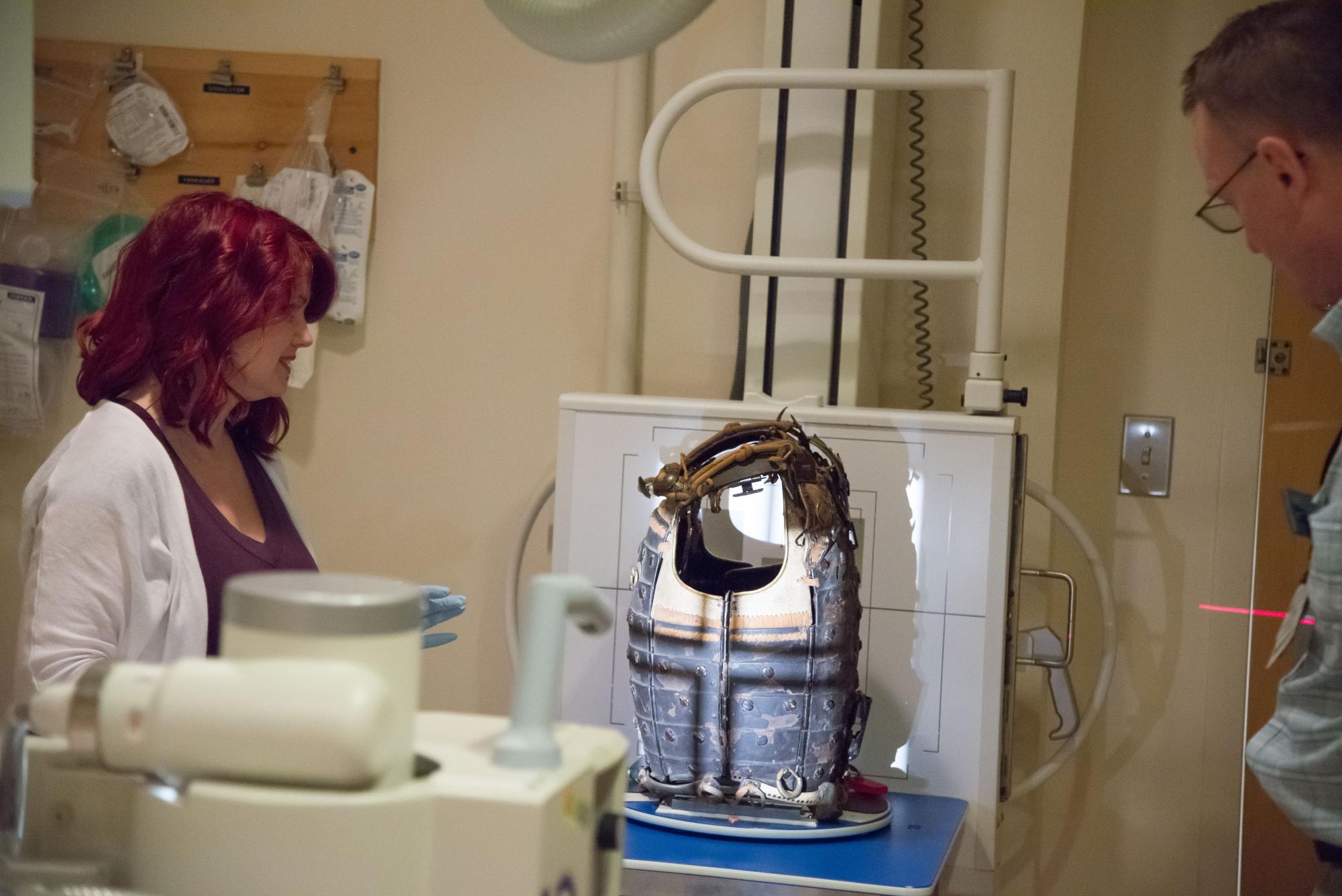
1. Andrew J. Bongiovanni, “Way of the Warrior”
Major: Leadership
Hometown: Hackettstown, NJ
2. Madison Brunet, “Legacy of the Symbolic Samurai Armor: From Africa to Peking”
Major: Environmental Science
Hometown: Timmons, Ontario, Canada
3. Ariyana Little, “Unforeseen Life”
Major: Psychology
Hometown: Barre, VT
4. McKenna Knapp, “Untitled”
Early College Program
Hometown: Northfield, VT
5. Daniel Moran, “Tebun’s Journal”
Major: Accounting
Hometown: Windsor, VT
6. Ellen Mensah, “The Fall of Kuwana”
Major: Management
Hometown: Tema, Ghana
7. Thomas Shepard, “The Father’s Armor”
Major: Architecture
Hometown: West Newbury, MA
8. Willa Long, “The Forgotten Samurai Warrior: Togukawa Kato”
Early College Program
Hometown: Washington, VT
9. Girija Eriu Griffin, “Ruminations of A Friend”
Early College Program
Hometown: Montpelier, VT
10. Kassandra Mancera Gonzalez, “Strange Lands, Old Battles”
Major: Criminal Justice
Hometown: Coats, NC
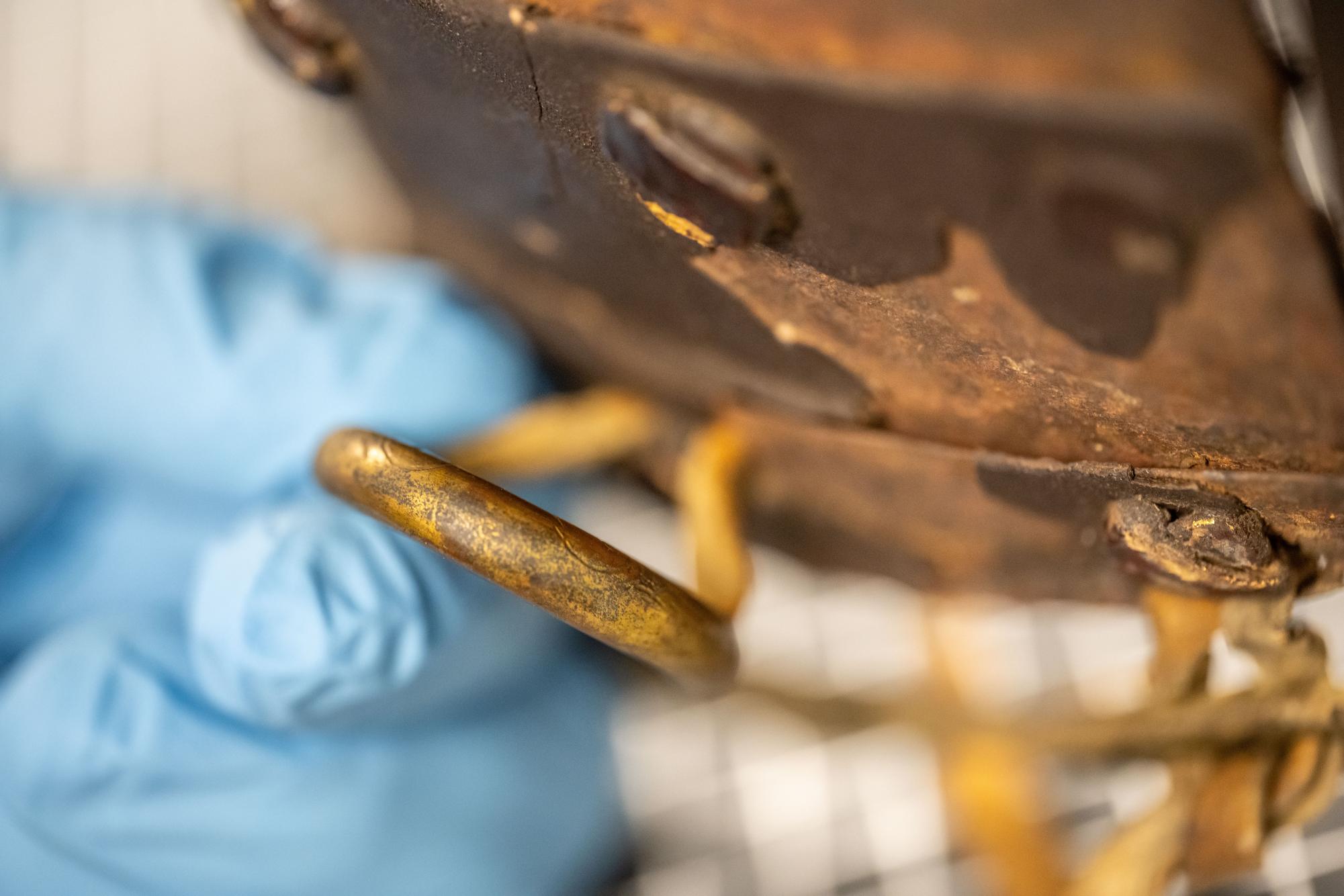
The rocking of the waves woke him up. The man was chained to the floor of a Portuguese ship. The deck was wet from the moisture of the sea, the air hot and humid, and the smell of dozens of people chained together near livestock was unbearable. The man had no idea where or how long they had been sailing; the days started blending into each other for months. He would often sit and contemplate how his actions got him to where he was and how he would get out of it.
The man’s name was Khalid. He had been fighting for a Moorish army in the Iberian Peninsula when the Portuguese captured him after a supply train he was guarding was attacked and overrun. All the others in the parade were killed, but the Portuguese commander respected his fighting spirit after seeing him defend the ground he stood upon when there was no chance of survival and decided to sell him as a slave instead. After being moved to a port in Portugal, Khalid was sold to a slaver and put on a ship set for an unknown destination.
One of the Portuguese sailors came down onto the deck where Khalid and the others were being held; the sailor had a bucket of water and several rags. He said some words, none of which Khalid knew, and used motions that symbolized that they should clean themselves. Quickly, others grabbed a rag and started to wash. Khalid also grabbed a rag, leaned over, and began speaking Arabic to one of the other captured slaves. The slave said they were required to wash because the ship was pulling into port and the slaves needed to look presentable.
After a while, several sailors came down and brought the slaves to the top deck, still chained at the wrists and ankles. The intense brightness of the sun hurt Khalid’s eyes. Squinting, he saw the port fisherman selling their catch of the day; people were moving all around. As they were brought off the ship, he could closely see what the people were wearing. Most were dressed in what looked like robes, some had on round straw hats that came to a tip at the top, and some were carrying fans, but he quickly noticed a group of four men walking through the crowd. By the way they walked, he could tell they were noble. Their clothes looked like robes but appeared much more maintained, and they carried two swords at their hips, one larger and one smaller, and when they passed, people would bow to them. The group of slaves was led toward a stand that had been set up.
These sword-wielding nobles came over to Khalid and the others to inspect them. One of the Portuguese sailors got onto the stand and began to speak a language that Khalid had never heard before. Khalid and several others had been the first ones pushed onto the frame. The sailor continued to babble in this foreign language as men would raise fans. Khalid had seen several slave auctions before and knew what was happening; they were being sold. The bidding was intense between two men battling back and forth, one wearing black robes with a single white flower on both shoulders, the other in green with three white flowers on each shoulder. They continued their battle until the one wearing black eventually beat the man in green, who, disappointed and frustrated, stormed off angrily. With a bow and exchange of coins, Khalid and the others were sold and pushed into a carriage.
The carriage took them to a big building with large compound walls. The courtyard was open with a well-raked rock pit, and the building had a triangle-style roof. Khalid was impressed with the size of everything. The carriage stopped, and they were ushered out. The man who bought them looked at the group, said some stern words, and walked away. It was apparent he was a severe man. A small wooden sword was placed down, and each person had to show if he could defend himself. Since Khalid was a warrior before, he knew how to use a sword to significant effect and impressed the group there to evaluate them. Later, they went to sleep and woke up before sunrise.
Khalid was brought to where others were training with wooden swords where he practiced and learned all day for several weeks. Over time, he also picked up some words in the new language, words like ‘dynamic’ and ‘samurai.’ He found out that his owner had just recently taken the castle they were residing in during a great battle where he had to fight his uncle.
That night, Khalid was taken to a building, led to a pit, and given a short sword. There, he saw another slave ready to fight Khalid. The fight started at the sound of a gong; the opponent swung at Khalid, aiming to kill him, but missed. Thanks to his prior training, Khalid was able to quickly end the enemy, and the fight was done. Cheers filled the room, and Khalid felt weird. For the first time since being captured, he felt like himself again. This happened every day for several months, and Khalid continued to win. By day, he would learn the language, finding out it was Japanese, then fight by night, and his owner continued to accumulate wealth.
One night, his master came down. Khalid was not brought to the pit like usual. Instead, his master decided to speak with him. They walked through the compound, surrounded by trees that had beautiful white leaves that resembled flowers. Two bodyguards stood on either side of his master, both carrying two swords on their hips. His master asked if Khalid had always been a slave, and Khalid responded that he was of noble birth and was captured in battle. His master nodded and understood why Khalid fought so hard to regain his honor. His master stated he had met another foreigner who had proved himself to be a great warrior, and he was made a samurai. Khalid felt respect for his master even if he was his owner.
As they were walking, several arrows were shot, one glancing his master in the shoulder, and the others found the two bodyguards. Six men jumped from the compound walls, clothed in black with their faces covered. His master drew his sword, but Khalid was defenseless, with his wrists still bound. The attackers ran towards Khalid’s owner; he was able to kill one of them but had been hit in the other shoulder by a glancing blow. Khalid saw a sword on the ground and grabbed it. He went after the attackers to defend himself and his master. He fought one while his master struggled to fend off the other three. Khalid got the better of his opponent quickly; the fighting in the pit had perfected his fighting abilities. He looked over and saw two-on-one for his master, who had been knocked to the ground and was in serious trouble. Khalid rushed over to help him, slashed both attackers quickly, and helped his master up. His master was in pain but thanked him. They investigated who the attackers were and came to find out they were samurai from a rival clan, which angered his master.
The following day, Khalid was called to see his master inside the house. Once in his presence, he knelt and bowed. His master expressed his gratitude for being saved the previous night, and remembering what he said, was indebted to Khalid. He told Khalid that he would become one of his bodyguards, not as a slave, but as a samurai. He showed Khalid a suit of armor and told him it was from the man he killed last night. As a sign of respect for Khalid, it was now his to wear. His master had taken it from the dead man’s family last night after the attacks as a symbol of retribution, then burned the man’s house to the ground. Khalid was asked to put it on; the suit was form-fitting, and the armor had overlapping plates of metal and leather, which would aid in blocking sword thrusts and arrows. Khalid was informed it was to be put on like a clam shell. Two things that stuck out for him were how incredibly light it was, nearly twenty pounds lighter than the armor he would wear back home, and how decorative it was. It almost seemed that the armor was also a status symbol, showing the clan’s prestige and power with intricate designs in the armor and the neck pad.
Khalid was honored and thanked his master many times, bowing to show respect. His master told him to no longer address him as master, he could address him as Lord Nobunaga. Khalid was told how Nobunaga was consolidating his rule over the other daimyo. As his bodyguard, Khalid followed Nobunaga for many months, and through many battles with his followers, he became angered by new policies, strict standards, and beliefs.
One day, as they were walking near a temple, a messenger came running and told Nobunaga how one of his followers had rebelled against him and sided with his enemies. They had marched a massive force to surround the city of Kyoto. Nobunaga quickly got his armor on and readied a small force of seventy to fight for as long as they possibly could. Soon, they were approached by many enemy samurai and peasant foot soldiers. Nobunaga, Khalid, and his loyal samurai cut down over half of the attackers before being forced back towards the temple for a better defensive position. As they worked their way back, an archer struck Nobunaga in the stomach. Khalid caught and dragged him inside the temple while some other samurai stayed to defend the entrance for as long as possible.
Khalid carefully laid Nobunaga on the ground. Nobunaga claimed victory was impossible, and he would have to commit the sacrificial rite of seppuku. Khalid was instructed to be the second in this act, required to cut Nobunaga’s head off once Nobunaga had stabbed himself in the stomach with a short dagger. They prepped the area for the ceremony. Nobunaga knelt and stabbed himself in the stomach and as he did, Khalid did as was required of him. Khalid stared at the body of the man he had respected as a fierce warrior and gave a respectful final bow before heading out to join the remaining samurai in one last final stand.
Khalid and the other samurai met a force coming up the steps of the temple. They fought bravely, taking out way more of the enemy than the enemy killed of them before finally, all of Nobunaga’s forces were killed, their swords clasped in their hands like true samurai warriors were supposed to. Khalid was killed, and his armor was restored to the family it was initially taken from to regain their honor. Though this was the end of Khalid, this was not the end of the armor that he wore. Eventually, it would find its way from China, and eventually to a small military school in Northfield, Vermont, called Norwich University, where history students would study and examine it.
Bibliography
Kato, About the Author: “The Honno-Ji Incident.” Samurai World, 20 May 2018, samurai-world.com/the-honno-ji-incident/.
“Oda Nobunaga.” Encyclopædia Britannica, Encyclopædia Britannica, inc., www.britannica.com/biography/Oda-Nobunaga. Accessed 14 Sept. 2023.
Afroetry, et al. “Black Slaves in 16th-17th Century Japan: Nanban 南蛮.” Dream of the Water Children: The Black Pacific, 6 Dec. 2015, dreamwaterchildren.net/2012/01/22/black-slaves-in-16th-17th-centuryjapan-nanban/.
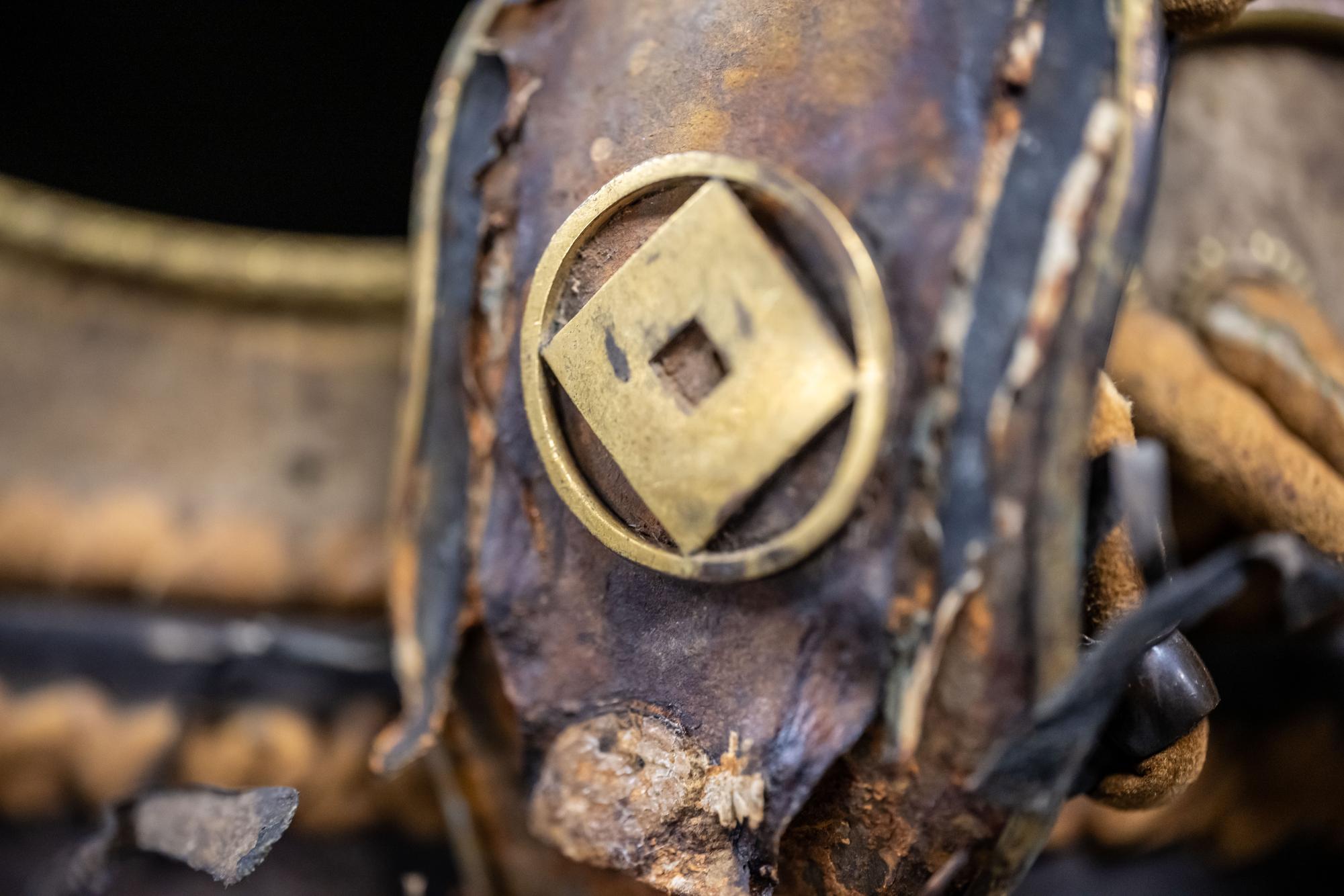
In the turbulent era of the mid to late 1500s, as Japan’s samurai clans clashed in a relentless struggle for power and honor, a tale of craftsmanship and valor emerged, woven into the very fabric of history.
Two expert armor makers, Handa and Iwai, labored furiously in their workshop amongst the sounds of slicing swords and the scent of blooming cherry blossoms. They diligently sculpted the steel plates that would become legendary samurai armor, yet their calloused hands and intense gazes reflected the accuracy of their work. Metalworking, lacquering, and textile artistry are just a few methods Handa and Iwai use to make samurai armor. Metal plates, such as iron or steel, were precisely hammered and fashioned into intricate shapes to start the shaping and forging process. Then, Handa and Iwai applied several coats of lacquer adds protection, durability, and a beautiful finish.
The skilled craftsman Handa had carried on the long tradition of producing armor started by his ancestors. His nimble fingers flew across the materials, infusing each one with strength and the wisdom of his ancestors. Iwai, Handa’s younger brother, had a contagious spirit and was eager to perfect the traditional art forms his sibling taught him.
Iwai was the “sane-uchi,” the one who created the sane that made up the foundational fabric, and Handa was the head artisan, known as the “katch-shi.”
One day, they would be surprised by an unconventional request from Oda Nobunaga, the feudal lord.
Japan was introduced to a captivating stranger named Yasuke in 1579. Towering at an impressive 6 shaku and 2 sun, his deep charcoal skin set him apart in a land of tradition. Crowds surged to glimpse the enigmatic African visitor who’d arrived in Kyoto. Here, he caught the attention of Oda Nobunaga, a formidable feudal lord known for his curiosity.
Yasuke’s uniqueness drew Nobunaga’s interest, leading to an unconventional alliance. This encounter would reshape their lives and Japan’s history, transcending cultural boundaries.
Yasuke, the African warrior, was great at martial arts, and Nobunaga was a great fan of the martial arts. Nobunaga spent many hours practicing this art. He was also a fan of how Yasuke carried the warrior spirit. Yasuke was fluent in Japanese, and he enjoyed dancing and performing Utenzi, a traditional style of Swahili narrative poetry honoring brave acts. All of Yasuke’s great attributes made Nobunaga grow fond of him. Nobunaga treated Yasuke like family.
After a year in Japan, Yasuke became even more interested in Japanese culture. He was intrigued by the symbolism of such simple things. The three main things that stood out to him were the cherry blossom trees, koi fish, and the dragon.
Odo Nobunaga recognized that Yasuke was now ready for battle and thus requested special armor to be fabricated. Handa and Iwai began crafting a Yokohagi Okegawa Ni-mai Do armor for the newcomer to Japan. They selected the iron sheets and carefully shaped them into chest and back plates. The artisans did this by heating, hammering, and curving the iron sheets on Yasuke’s slender body. Leather cords were employed to link the clamshell-like armor together. The hinge on the left side of the armor allowed for securing the armor to the body and the leather straps on the right to tighten it around the body. Layers of silk and cotton padding were added for comfort and protection for the neck. The shoulder claps were made of leather and had the family emblem called the ‘Mon’ made of bronze. Handa and Iwai carefully added all the elements required, such as the powder loop and the iron piece on the back plate for flag bearers, and they ensured the leather would withstand on the battlefield. Yasuke emerged as the unlikely wearer of this masterpiece.
These meticulous and highly skilled artisans worked rapidly to fabricate armor for the first foreign-born man to achieve the status of a samurai warrior. They made sure to include a fierce koi fish, delicate cherry blossoms, a dragon, and vines of unity on his armor, as requested by Nobunaga.
Handa would hand-carve the cherry blossoms on the back plate of the armor. He then added the koi fish design on the powder loop, followed by the dragon. Handa then added many vines along the neck hole of the armor as a symbol of unity. Handa felt that the vines were an excellent addition to demonstrate the shared commitment, giving Yasuke strength and perseverance. As a foreigner in a land where he stood out, vines on Yasuke’s armor signified his integration into the samurai brotherhood. It demonstrates that Handa accepted and trusted Yasuke. Handa paid great attention to detail to perfect Yasuke’s armor.
Yasuke wanted koi fish on his armor because he remembered the tale told by the Japanese; “Each year, thousands of koi leave the sea to swim up the Yellow River. By bravely flapping their fins, they swim upstream against the current and meet at the Dragon Gate waterfall. This waterfall is said to be of such strength that it’s swifter than the arrows of a hundred warriors.” Yasuke was inspired by the fact that to succeed, koi fish face many obstacles; they brave predators, fishermen, and many other dangers. Yasuke wanted to be like a koi fish on the battlefield.
The dragon represents a creature who protects Buddhism and symbolizes the powerful and wise guardians that protect people from danger. Lastly, the cherry blossom signifies a metaphor for the fleeting beauty of living. A single fallen tree symbolizes a fallen warrior who sacrificed their life for another.
The idea of a non-Japanese fighter carrying such a high title was regarded with shock when Nobunaga granted Yasuke the unheard-of rank of samurai. Yasuke set off on a spectacular trip on the Japanese battlefields, making history as the first warrior who was not Japanese. He bravely participated in pivotal battles alongside the mighty Oda Nobunaga in 1582. Their bond, forged in the fire of war, was unbreakable. But Yasuke would also see the tragedy that occurred to his esteemed lord while the battle raged around him. Yasuke was by his lord’s side that fateful night when the malicious Akechi Mitsuhide turned on Nobunaga and set his palace on fire. Oda Nobunaga decided to commit seppuku, an honorable ritual death, as the castle burned down and trapped him within. To ensure that his memory would remain despite tragedy, Nobunaga gave Yasuke an essential task before he passed away: to decapitate him and carry his head to his son along with his legendary sword.
Upon finishing his mission, Yasuke embarked on a journey that eventually led him to China, a realm of emperors, dynasties, and ancient traditions. His formidable combat skills, forged on the battlefields of Japan, caught the attention of the ruthless warlords who wanted to exploit his talents. Yasuke’s reputation as a loyal warrior became a blessing and a curse. Ultimately, Yasuke was captured and brought to China. He was now under the service of the Blood Prince. As the tides of power shifted, Yasuke had to battle against his own. Because of his loyalty towards his feudal lord, internal conflict grew, and his unloyalty towards the Blood Prince would lead him to meet the executioner’s blade, leaving his bloody, legendary armor in Peking, China.
Bibliography
“Not Just the Tudors: The African Samurai on Apple Podcasts.” Apple Podcasts, podcasts.apple.com/ca/podcast/the-african-samurai/id1564113869?i=1000623027412. Accessed 18 Nov. 2023.
Avenue, Japan. “Japanese Koi Fish Meaning.” Japan Avenue, japan-avenue.com/blogs/japan/koi-fish-meaning.
“Dragon | Traditional Kyoto.” Traditional Kyoto, traditionalkyoto.com/culture/figures/dragon/.
“Japanese Samurai Armor: Preserving Tradition and Artistry.” 株式会社水玄京, 8 July 2023, suigenkyo.com/en/article-japanese-samurai. Accessed 18 Nov. 2023.
Mohamud, Naima. “Yasuke: The Mysterious African Samurai.” BBC News, 13 Oct. 2019, www.bbc.com/news/world-africa-48542673.
Morihiro Ogawa, et al. Art of the Samurai : Japanese Arms and Armor, 1156-1868. New York, Metropolitan Museum Of Art, 2009.
“What Is the True Meaning of Japan’s Sakura Cherry Blossom? – Sakuraco.” Sakura Co, 16 Aug. 2021, sakura.co/blog/what-does-sakura-mean-to-japan/.
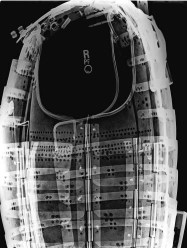
There I sat, blade resting on my neck, head bent, and eyes trained on the floor. I knew this was it, my time, all my work had led to this. Death by a blade similar to the one I carried on my hip. I was not scared; I did not fear the pain or what would come. Death is something you make peace with early on if you are a person like me. Blood would finally be spilled on this armor, its green hues tinged with copper. I was lucky to make it this far and had risen this much. I was paving a path for those after me, for all those who believed they had nowhere to go and no purpose. This was not how it was meant to end though, not this soon, not this quickly, and surely not this forgettable. I was meant to be remembered, my story to be told to those who came after. Perhaps it would be, perhaps someone would remember me.
***
It was the year 1577, twelve years before my imminent death. I was eight years old, traveling with a group of Portuguese missionaries. Taken from my home and forced to travel with people I did not know. I was alone in this world, no family, friends; my life meant little to anybody. I had gathered that I was meant to be sold as a servant to whomever we were traveling to meet, for I did not know our destination or even what day it was. What was to come of me, I did not know, I could not foresee the next years of my life and what it would lead to.
After a few months of travel, we arrived in a place I would learn was Japan. The skin of the people here was a stark contrast to mine. Their skin was pale, similar to the tusks of an elephant. Their clothes were of stunning colors in multiple shades, the fabric draping and thick. The women I passed had painted faces, black teeth, and bright cherry red lips. The world here was so different from what I had known in Africa, it was quite the culture shock.
I was led to the house of a Daimyo, who happened to be a part of the Miyoshi clan, that I would later represent. He was introduced to me as ‘tono,’ and that was all I was to refer to him as. I moved into his house, called a shoin-zukuri, and was dressed in a kataginu. I learned quickly that this was not going to be what traditional servants did. In my quarters, I saw a piece of armor sitting in a closet-like case. It was a green hue, adorned with beautiful details, the shoulder straps held a symbol, a square inside a circle. The symbol of the clan I now served. My tono immediately began to teach me the ways of the sword. I picked the skills up quickly, even though I was young. Through this training, I became fluent in Japanese. The Japanese culture became a part of me, as I felt my old life slipping away, out of my memory. I didn’t even remember my old life before learning the ways of the sword. Training as a samurai was not easy, however, I focused all my attention on it, as I had nothing else to keep me going in this life. I thought that maybe, just maybe, if I was able to do well, I could be someone. I wouldn’t just be a servant boy from Africa, and that is exactly what I set out to do.
It was six years later when my tono let me wear the armor that had stared at me for years. It sat in my room, and I felt myself itching to put it on. He told me, “You have earned it, you have gained the honor that it means to put on this armor and resemble this clan.”
Hearing those words gave me pride. I came to view this man as a father figure, even though I knew he never truly could be. I had no family; all I knew was duty and my tono. This armor held a different type of significance. It was to hold the flag of our clan, of my clan. While I was trained in the way of the sword, this armor was of a significance that required less sword ability. I was to carry the weight of not only the true flag but the weight on my soul. I represented this clan in its entirety.
It was another six years until I had my most important assignment to date. Still wearing my same intricate armor that clung to me like a second skin, feeling it almost weightless on my body, despite it weighing around fifteen pounds. I would be heading to China for the first time as an emissary. A dangerous job as we never knew how the emperor and leaders of China would react. I was going to discuss trading agreements amongst our countries, along with other samurai soldiers.
Once we arrived in China, we made our way directly to the empire. However, we did not get the greeting we expected. We were flanked by Chinese samurai on all sides, swords drawn. They forced us into the palace and in front of the emperor. They had one of our men explain why we were there; however, it was not taken well at all, “How dare you march into my land and request orders on trade,” the emperor hissed.
He forced us to our knees, explaining that this would speak his decision to all of Japan. The sword felt uncomfortably cool against my neck. My years leading up to this moment flashed before my eyes. The sword lifted and just like that, my life was no more. All that was left of me was my cold body and the bloody armor that resembled everything I knew for my years in Japan. My blood spilled upon the flag I carried on my back, a symbol of our failure. My life went unseen by many, but I was an African samurai, and my story will not be forgotten.
Bibliography
Japacul. “The History of Japanese Kimono Clothing.” Masterpieces of Japanese Culture, 13 Nov. 2019, www.masterpiece-of-japanese-culture.com/traditional-clothing/historytraditional-japaneseclothing#:~:text=In%20the%201500s%2C%20the%20features,fine%20strips)%20until%2 0Edo%20Period.
“Modes of Address.” Sengoku Daimyo, sengokudaimyo.com/address. Accessed 20 Sept. 2023.
“Red Lips, White Face: The Cultural History of Japanese Beauty: Live Japan Travel Guide.” LIVE JAPAN, livejapan.com/en/in-tokyo/in-pref-tokyo/intokyo_train_station/article-a0001292/ Accessed 20 S
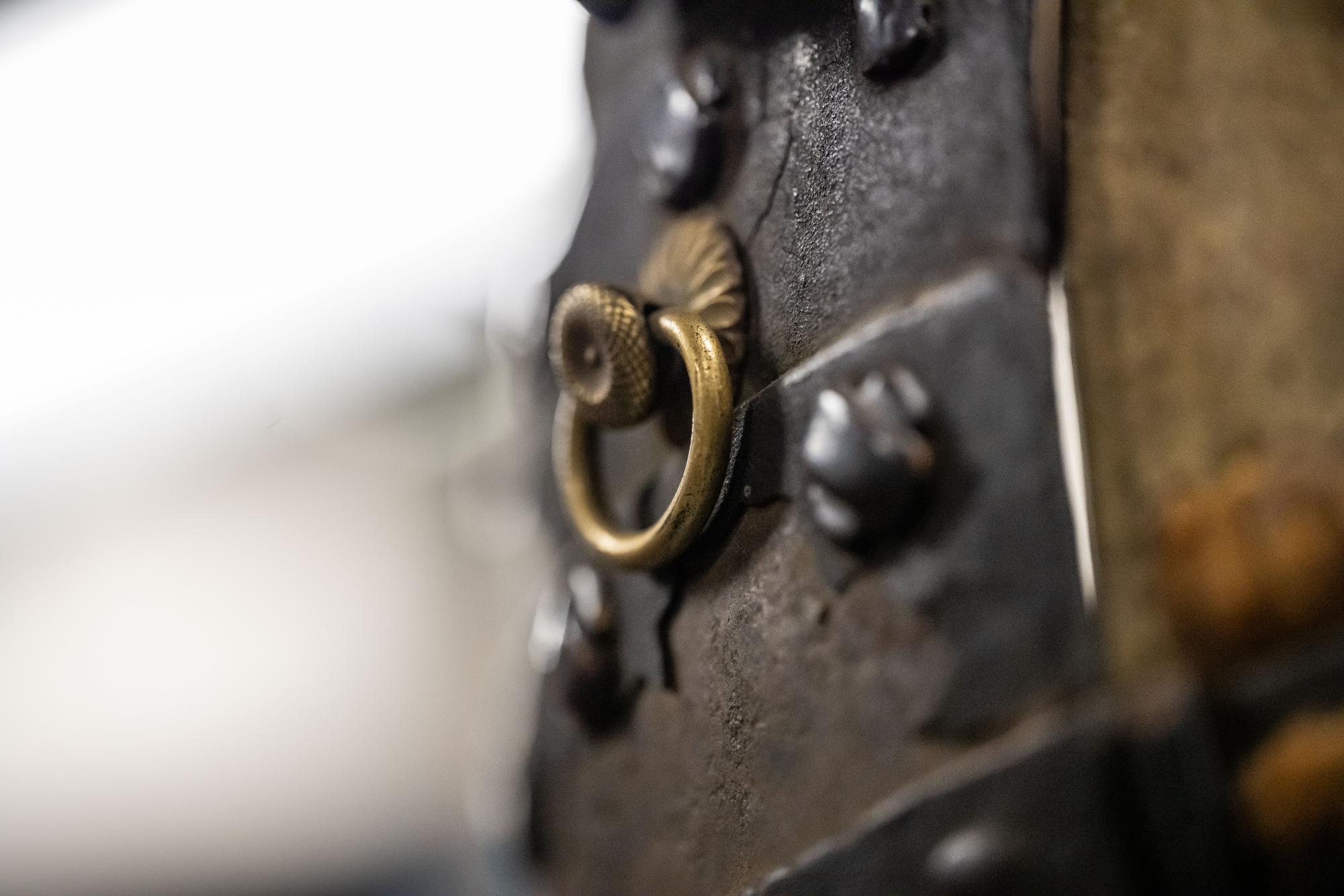
The year was 1765, I was on a ship, and I did not know where I was going. Everything was dark, my body was sore, and my brain was tired. I missed home. I missed mother yelling at brother and me to watch where we step and to stop teasing our sister. I wished I was back in the village; I hate this. I felt the boat come to a stop and so did everyone else One woman who was holding two of her children looked so malnourished that I could see the bones right through her skin. The man next to me said, “We are going to the new world.” I wasn’t sure what village he was from, but he did speak the same language as me. Little did he know we were not going to the new world, we were going to Asia, to be specific, Japan.
We were put into two lines: women and men, children were separated from their parents and taken somewhere unknown. Those children never saw their mothers again, just like me. Women were screaming for their children while the men told them to be quiet so the white men would not harm them. We were all going to be harmed at some point; it was just a matter of time. We got off the ship and from there we were taken to smaller ships. I wasn’t sure where we were, but someone said India; the white men were everywhere though. When I was put onto a smaller ship, the man conducting it was not white; he had pale skin but was not a white man at all. He asked us if we would like pieces of the fruit he was eating. I took a piece and decided to sit on the back of the boat There were about ten other men on the boat with me. I was so tired, so when the boat took off, I fell asleep, dreaming of home.
I was born in the year 1705 or maybe 1706, I wasn’t sure; we did not keep record in the village. My mother and father named me Mandla Dlamini. I was supposed to grow up big and strong like my father and become a fisherman. The village relied on fish from the big stream that flowed through the center of our huts. Men would be out all day, working hard to provide fish for their families, and the wives would be out working on the gardens. Each family had a garden and would trade with each other for specific foods. We never left the village, if we did, we would most likely never come back. That’s what happened to me.
On my 18th birthday I wanted to see what was out there; I was too curious to consider that it was dangerous. I stayed up all night, and when it sounded like everyone was asleep, I left my house. I wanted to go see the ocean, the men in my village would talk about it as if it was the best part of their lives; I needed to go. When I got to the harbor there were so many people there. The colonizers had taken over, and the next thing I knew, these men were shouting at me, and I was running. In our village, I was the fastest boy, but these men had horses. Next thing I knew I was stuck in a line with other men who were about my age, and we were being loaded onto a boat.
When we all were taken off the tiny boat, things were different. There were trees that looked beautiful, nothing like I had seen before. Everyone was dressed in clothing from head to toe, it was shiny. I would later find out that it was silk that everyone was wearing, and that I too would be wearing. We were taken into a building that must have been a palace; it was so big, and gold was everywhere. As we walked in, we were lined up in front of a couple of steps. There were only six men left now.
A man walked out and stood on top of those gold shiny stairs in front of me. The man started by saying, “I am Emperor Go-Sakuramachi. You have been brought here to become my samurai.” After the man finished speaking, he quickly left. I felt so confused and did not know what a samurai was, so how could I become one? All six of us followed these three men who wore this strange armor, and the next thing that happened changed my entire life.
It had been months, at least I thought so. I now wore the armor that the rest of the men around me wore, and on top of that, I knew what a samurai was. I follow a code, where I must put the emperor’s life before my own. I learned a good amount of the Japanese language; they also taught me how to read. When I was a child, I always wanted to be a magical being; I would play with the younger boys, and now it felt like I was one. I carried a sword on me; it was heavy, but I could wield it with force. However, I was treated differently along with the other five men that came with me. We all shared a large space for living, and we did not get paid like the other samurai.
One morning we woke up from a terrible stench and found that our living quarters were on fire. As we quickly put on our armor, we ran straight outside to see who did this. It was a rebel group of ex-warriors. These men had been creating chaos in the town for months. Whenever we tried to catch them, they would flee to the mountains, but not this time. All six of us were wearing old armor; it was from the Miyoshi Clan. We felt like true warriors.
As we stepped outside there were eight men and six of us. We did not know how we would defeat them, but we had to. The fight started with a scream from the rebels, and then we were running headfirst into the men. We each dueled a man and would have to switch because we were outnumbered. Soon, there were only two of the rebels left and they were not going to give up. I looked up and saw more samurais sent by the emperor riding up to us on horses, so I knew it was over for the rebels, but it was too late for me. I looked back at my opponent and his sword was at the side of my neck. Everything was gone.
Works Cited
Cartwright, M. (2019, June 28). Sengoku Period . Retrieved from World History Encyclopedia: https://www.worldhistory.org/Sengoku_Period/
Mohamud, N. (2018, October 14). Yaskue:The mysterious African Samuri . Retrieved from BBC: https://www.bbc.com/news/world-africa-48542673
Wikipedia . (2023, June 12). Empress Go-Sakuramachi . Retrieved from Wikipedia : https://en.wikipedia.org/wiki/Empress_Go-Sakuramachi
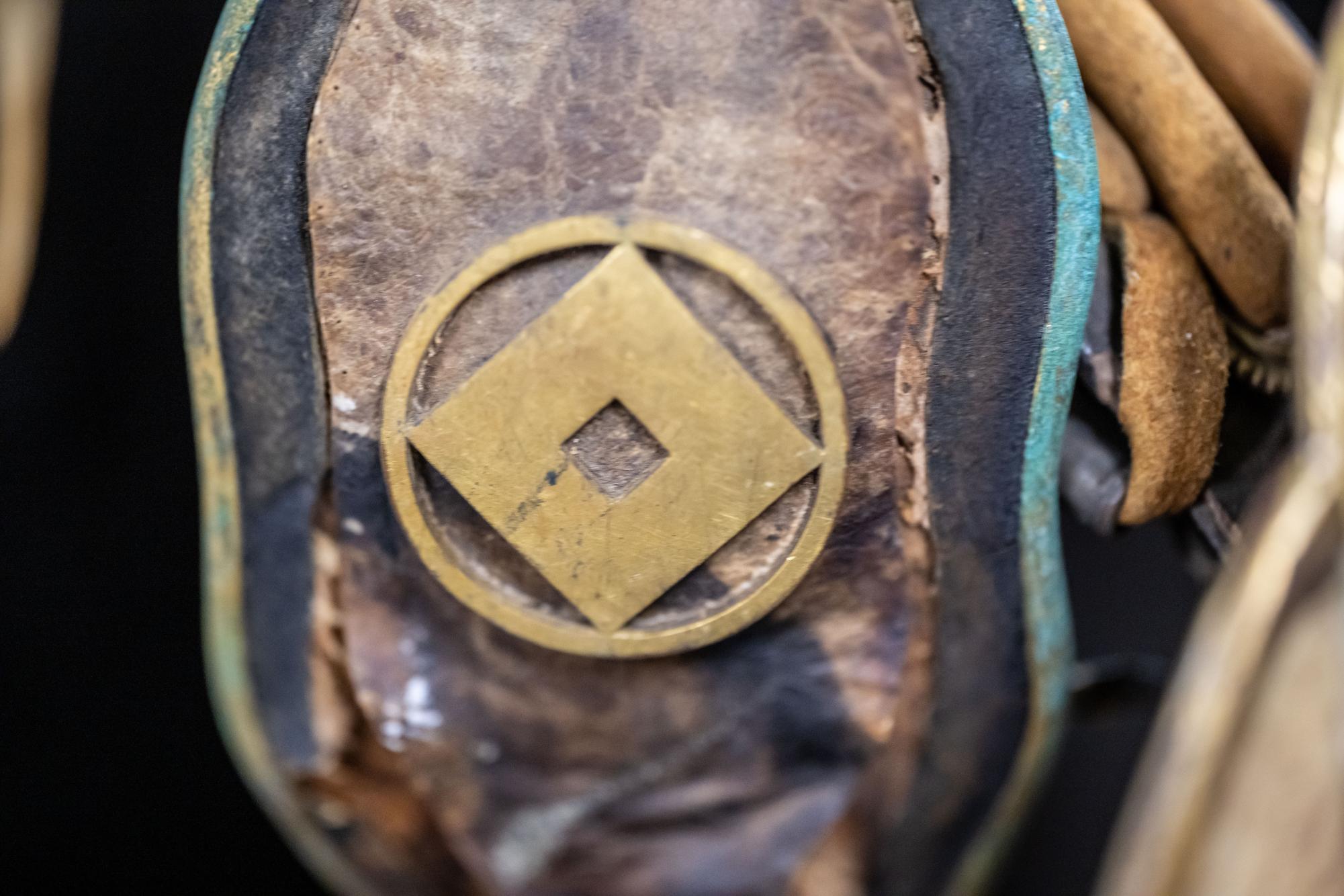
To be honest, I don’t know why I decided to keep a journal, but it seems like a good idea especially since a lot of interesting things have been happening since I became an apprentice for Marumasa.
Well, the day started like any other. Marumasa had me start the forge and begin getting Choji oil out to sharpen and polish the blades he had set out for me. But today someone came to our forge, and I was shocked to see it was Tokugawa Ieyasu. I immediately got to my knees and bowed.
Tokugawa looked down. “Stand up. I need to speak with your master. It is of utmost importance.”
I stood up. “Unfortunately, Master is out collecting metal, and I have no idea where he is. Would you like some tea while you wait for him?” I gestured toward the private waiting room while opening the door for him to sit. Tokugawa walked to sit down. “I will be right back,” I said.
As I walked off, all I could think about was how peculiar the item was that the lord was holding. It was small and made of metal and wood. What was that? I began to ponder while making the tea, accidentally grabbing the wrong type of tea. “Sorry for the wait,” I said as I put down the tea, “May I sit with you, my lord?”
Tokugawa gestured for me to sit near him.
After sitting down, I began pouring the tea and setting the cups in the right place. “My lord, if I may ask, how do you know my master?”
Before taking a sip of his tea, Tokugawa put the cup down. “Well, I met Marumasa when we were much younger, he made these swords you see at my side. You have quite the teacher. Make sure to learn a lot.” Tokugawa picked up the teacup and took a sip, but as he did, his face turned sour. “What the hell did you just give me?!”
Another voice suddenly spoke up. “What do you want? You outcast me, now you are here to visit.”
Tokugawa looked over to see Marumasa holding a bag and a kiseru smoking in his other hand.
“To what do I owe the great Tokugawa to visit my humble shop?” Marumasa asked sarcastically.
Tokugawa sighed. “The tea is not important, but what is this?” Tokugawa put the flintlock on the table.
Marumasa looked inquisitively at the flintlock. “What is it? It doesn’t look like anything I have ever made.”
“It isn’t something you have made. We received it from a trade with the Portuguese. I will show you how it works,” Tokugawa explained.
Marumasa dropped his bag. “Kid, take this to the forge quickly and meet us outside,” he said while walking outside with the lord.
I stood up and grabbed the bag Marumasa had dropped. It made a loud rattle as if a bunch of swords were bouncing off each other. I put the bag in the forge room and ran over as instructed. When I got outside, a tatami mat had been placed on a table and the lord held the flintlock in one hand as I thought I heard thunder and saw smoke come from it. When I glanced at the tatami mat, there was a hole that was perfectly round. I couldn’t believe it.
Marumasa spoke up, “What is that, Tokugawa?”
“It is called a flintlock. I believe the Portuguese had another name for it, a firearm is what they called it. It uses these things called musket balls.” Tokugawa pulled out a ball and set it on the table.
“What do you want me to do about it, Tokugawa?!” Marumasa exclaimed. “Can these metal balls be stopped?!”
Tokugawa perked up as if an idea struck him. “Now I know you are not an armor smith, but do you think you could make an armor set that might be able to stop it?”
Marumasa took a drag of his pipe while sighing. “You know I am a weapons smith, not an armor smith. Although if you leave the armor with me, I may be able to make it more effective.”
Tokugawa looked surprised at how something like the flintlock could be improved. “Well, I will show you and your apprentice how to reload it.” After a long lesson on how to reload and shoot it, Tokugawa left.
“Well, now that he has left, kid, we’ve got some work to do,” Marumasa said while smiling.
“Do you want me to start sharpening blades?” I asked.
“You know, kid, I think you should join me in the forge today. I think you may like it. I am going to show you how to make plates for armor. Follow me.”
I followed Marumasa diligently. He entered the forge and grabbed an old armor set off the shelf along with the flintlock. “So, first you are going to test the flintlock against this old armor.” He proceeded to hand them over to me and pushed me outside while he remained inside.
Guess I am on my own again to learn, I thought. I walked over and put the armor against the tree line and took aim at it. My first shot missed completely; it took more attempts than I would like to admit. When I did finally hit the armor, the shot broke through the leather on the front, but stopped after hitting the metal plate in the back. I ran back inside to tell Marumasa what happened, but when I went inside, I was told, “Tebun, it is time for dinner,” so I stopped what I was doing and went to eat.
For the next couple of weeks, Marumasa taught me about armor smithing. He taught me how to put armor plates and leather together until I had a rough idea, then he said I could make my own chest piece, so I decided to start by drawing up a design for him. It was an armor that opened on the left like other armor, and Marumasa approved of my design. I began to assemble the plates and get the leather ready to shape, but I thought of an extra design change. What if I added extra plating in between the leather and metal? After I finished putting the armor together, it was heavier than the others I made with Master. I wanted to test the armor, but I had to wait for the leather to cure.
All of a sudden, Marumasa picked up the armor and brought it outside, grabbing the flintlock and shooting it at point-blank range. Marumasa looked at me and smiled. “The ball did not pierce the metal, but it dented where it hit. Now let’s open the armor.”
As he tried to open the armor, Marumasa realized that the hinge bent when the metal dented. “Well, that’s a problem. Maybe instead of it opening from just one hinge, we could make the armor also open at the shoulders so even if it gets damaged, they still can take it off. Let’s try again with these new changes.”
Marumasa walked back inside and turned on the forge. “Are you going to stand outside or are you going to make it with me?” Marumasa shouted. I ran inside as fast as I could, excited to make my next item.
This was how I started my journey as a smith.
Work Cited
Bedrosov, Boris. “The Evolution of Japanese Armour.” myArmoury.Com, myarmoury.com/feature_jpn_armour.html. Accessed 21 Sept. 2023.
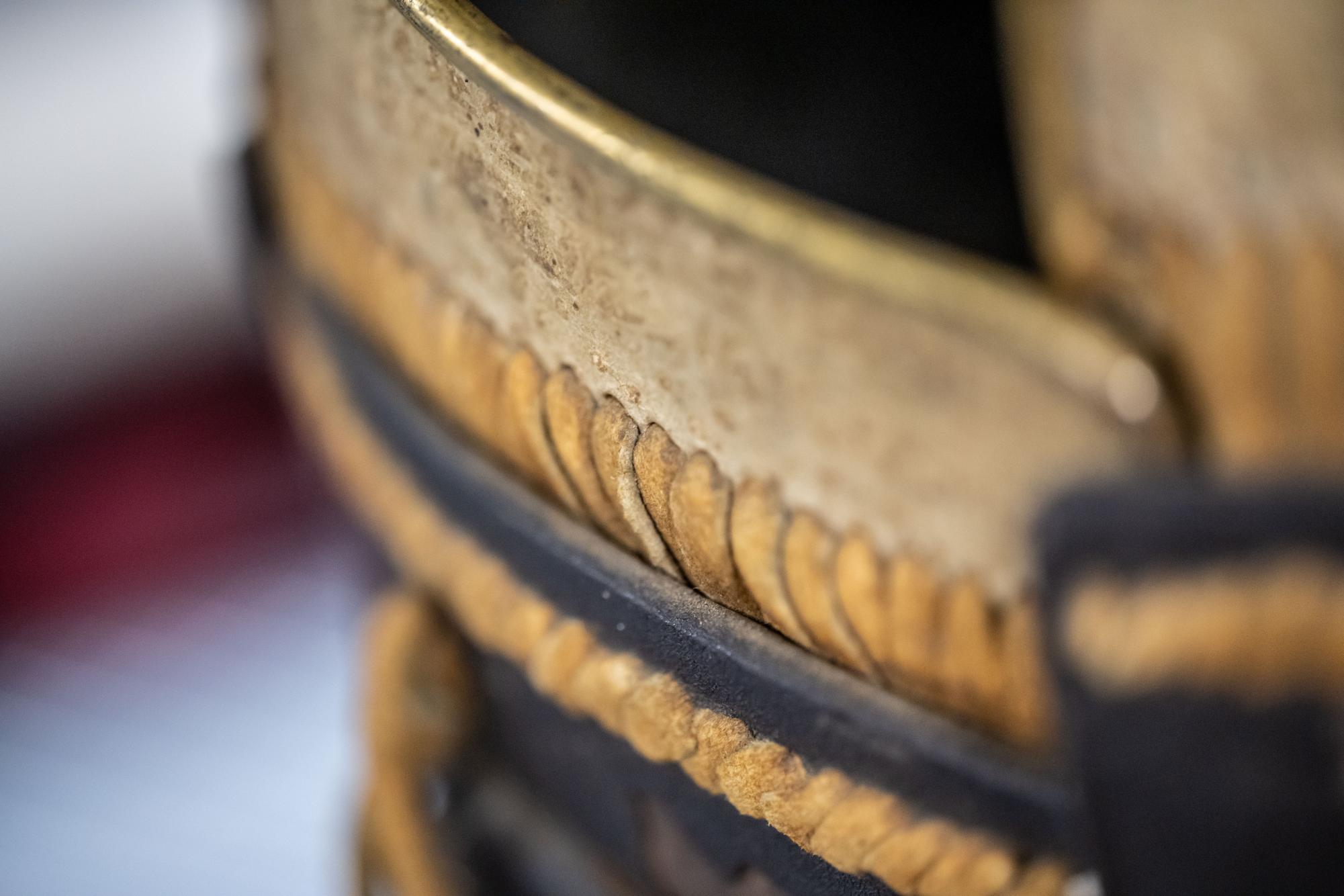
The tears of the rivers and the streams paved the way down the city as the war began. Villages and cities braced themselves for the impending havoc that was to rain down. War generals and clans gathered their weaponry, their bowmen stocked up on thousands of arrows, their gunmen cleaned their muskets and trained in the gunning arena. This was a time where power was desired by many. Warlords and clan heads were clashing heads with the desire to be the next to control Japan. Many pledged allegiance to the daimyos whom they were willing to lay their lives down for. Even with the warlords at the center of these disruptions, the spotlight and center point of these were the warriors and samurai. Warlords gathered their warrior samurai at the break of dawn to gain an upper hand over rival warlords. In the small town of Kuwana in Japan under the Miyoshi clan, samurai warriors gathered at dawn in preparation for the upcoming war between warlords. Word had gotten to the clan from an insider in the enemy warlord’s encampment of a planned attack on the Miyoshi clan. In that respect, preparations were being made to launch an attack on the alleged threat.
A samurai named Akechi Hanzo had become the secret weapon for the warriors in Kuwana. Akechi was a peculiar breed of warrior, none like the Japanese had ever seen. With Akechi being different from them, many felt he would not even survive through training, but he proved them wrong. The leader of the warriors in Kuwana, Hattori Nagamasa, saw a sliver of hope in Akechi that others did not see. He began training Akechi unlike how he trained his other warriors. Akechi became skilled in just a few months in battle techniques that took many years to learn and master. Akechi’s achievements had not gone unseen by the other warriors.
Hattori had never met anyone like Akechi in his life and was so impressed that he made Akechi the commander of his battalion. Akechi, however, maintained his tiny build, which meant a special type of armor was to be made for him as he was the smallest in the battalion. The armor worn by samurai was made from a mixture of metal, silk, and leather. Akechi’s armor consisted of a gorget silk collar of silk and metal beading, and an armored chest plate plated with iron and covered with leather. The chest armor also had buckles to hold up the armor. The craftsman made sure to intricately decorate the armor with the Miyoshi clan marker and incised decorative flowers and vines on the metal parts. The armor was also decorated with dragons as symbols of strength and courage, cherry blossoms representing new beginnings, and coy fish designs representing perseverance and bravery. A protective skirt was made with leather, wool, and iron to protect the groin during battle.
About a few months prior, there had been an invasion by foreigners, Europeans who brought their western culture to Japan. Whispers went round the cities by women of those white bred foreigners. Many natives of Japan were not thrilled by this intrusion at a time when the nation was plagued with war and unrest. In the time the foreigners had visited the land, there had been the mass initiative by the Europeans to introduce Christianity to the people of Japan. Warlords such as Oda Nobunaga and Tokugawa Ieyasu were vocal about their strong disdain for the foreign initiative to influence the culture and values of Japan.
The Europeans, however, brought with them something that would change the face of war in Japan; gunpowder and firearms. With the introduction of these items, a new element of weaponry was introduced into battle. These Europeans also brought with them another element of tactical advantage for the Japanese, slaves. Men who had been captured from Africa to serve as slaves. The Europeans offered slaves to serve as warriors to fight on behalf of the warlords. Among these slaves was Akechi, a tiny built and malnourished man. The slaves were smaller than most Japanese warriors, which the daimyos believed meant that the slaves would be faster and more agile during battle. In the short period the slaves had been added to the warriors, they were trained in sword techniques, musket usage, and self-defense tactics. Through that training, Akechi rose through the ranks. Now, with Akechi leading the battalion to battle alongside Hattori, their ambush attack on the warlord would take effect two days in advance of when they had been informed that the enemy warlord’s attack would be launched. Confident in their training and ambush plan, Hattori’s battalion set up camp on the outskirts of the enemy warlord’s camp to launch an attack in the middle of the night when the enemy’s guard would be down.
As Hattori and Akechi discussed the battle plan in Hattori’s tent to ensure that their attack would be successful, there was a sudden war cry that did not belong to the battalion. The enemy warlord was launching a surprise attack against them. Akechi and Hattori rushed out of the tent, and they were met with a blood bath. Arrows stuck out of the heads of their soldiers, and bullet-sized holes were in the chests of the men whom they had fought alongside. Half the battalion had been taken out with the remaining half fighting for their lives. With Akechi’s allegiance to the Miyoshi clan and Hattori, Akechi made it his mission to protect Hattori in battle.
Finally, a new dawn broke. The entire battalion had been wiped out, excluding those who pledged allegiance to the enemy warlord. Akechi and Hattori had been captured and taken captive by the warlord. The two were brought before the warlord, who looked intrigued by the appearance of a breed of warrior he had never seen in his life. He decided to spare Akechi’s life only if he pledged allegiance to him. Akechi refused and was made to see the consequence of refusing to pledge allegiance, beheading. Hattori refused to serve another warlord and was beheaded in front of Akechi. Akechi’s life was spared even though he refused to pledge allegiance to the enemy warlord. Akechi was made to become the warlord’s personal warrior with whom he traveled as that was the only way to spare his life.
A year later, on a journey to Peking, China, the enemy warlord was accompanied by Akechi as his protector. Akechi still wore the armor made for him by the Miyoshi. In Peking however, Akechi tried to escape, which led to his gruesome beheading upon arrival in Peking by the enemy warlord himself.

A moment of chaos engulfed the island of Japan at the time of my creation. The 1560s were upon us. A civil war between multiple clans was fought by the samurai, warriors who used the most honorable weapons of war. These warriors fought mainly with swords rather than cowering behind the gunpowder killing machines that the Europeans cursed upon our lands. To protect the warrior within, I was crafted from iron laced horizontally with rivets to expel any blow from swords wielded by opposing clans. Leather, silk, cotton, and wool held me together and transitioned to the protective iron that protected the flesh of the samurai. Lacquered bronze on leather rested on my shoulders to symbolize the Miyoshi Clan I was created for.
Then, the day came. I was introduced to my warrior—the one I would protect for the rest of his time. This was not the usual samurai found in Japan. Yasuke was not the first foreign-born Samurai. When Yasuke was just a child, the 14th shogun, Yoshihide Ashikaga, captured Yasuke’s father. During this process, Ashikaga saw potential in creating a warrior to fight for the Miyoshi Clan. I was granted as a gift to the samurai father whose identity remained a secret to all of Japan for the rest of time. We were sent to Kyoto, the capital. Here, my samurai fought as I protected. Nobunaga Oda descended upon the city. My samurai fought hard as others in our clan were slain, but I held strong. No sword of Nobunaga’s clan could penetrate the armor that I provided. While the father of Yasuke put up an excellent fight, using all the skills that he had trained tirelessly to acquire, the Miyoshi Clan was no match for Nobunaga’s army.
We were captured as others returned to Awa, the home base of the Miyoshi. Nobunaga approached us after our capture. While I was to protect the warrior within, we felt as if this were the end. There was nothing I could do to stop myself from being removed from the body of the Samurai. We would surely perish in the arms of the enemy, or so we thought. I was not separated from the African samurai within. We were alive.
Nobunaga came to us and told us his plan. The plan to save Japan was to unite all those who inhabited the island. Soon, we would all be under one leadership. I was able to continue doing my duties of protecting the one who wields the sword. All that Nobunaga asked was that we protect the city of Kyoto in his honor. The samurai protected the land as the lead and leather that I am composed of protected his flesh. We were tired from the long battles we fought, but we believed in Nobunaga’s vision of unifying Japan so that we may live in peace one day.
In 1573, we received word that our original clan had fallen. Awa had been captured. I was joyful that the wars between the peoples of this land were ending. I was also saddened that the lacquered bronze and leather shoulders symbolizing the clan we were once a part of no longer existed. In 1597, the one I was protecting received excellent news. The son, Yasuke, had arrived in Japan. He was a wonder to the people of this land. Nobunaga was inspired by the efforts of the father and believed it was time for them to be reunited. But the father was ill. He was unable to fight alongside his son. I could protect the father from the wrath of the enemy, but not the wrath of time and age. My duties of protecting the samurai were coming to an end.
On his deathbed, Yasuke arrived to say goodbye to his father. My warrior’s time was here. The father offered me as a gift to his son so that I may go on protecting the young samurai as I did for the father. The father took his blade, the one he wielded in all the battles that we fought together. He brought his blade against the skin of his neck and ended the suffering old age had brought upon him. The warrior’s blood flowed down his neck as he took his last breath, and the life left his eyes. Red stains of the man whom I once protected stained the cloth of my neck. Yasuke slowly removed me from his father’s deceased body, proud of his father’s accomplishments. The father’s death was honorable in the eyes of the people whose culture they found themselves ingrained in. The samurai I once protected was gone, but I remained to tell a story of how the people of this island once lived, fought, and died for their country.
Citations:
Mohamud, Naima. “Yasuke: The Mysterious African Samurai.” BBC News, BBC, 13 Oct. 2019, Japanese-English Bilingual Corpus of Wikipedia’s Kyoto Articles. Retrieved 2 December 2020. Japanese-English Bilingual Corpus of Wikipedia’s Kyoto Articles. Retrieved 2 December 2020.
“Construction.” Tonbo Armory, 9 Sept. 2022,
“Sengoku Jidai: Japan’s Warring States Period.” National Parks Service, U.S. Department of the Interior, Accessed 21 Sept. 2023
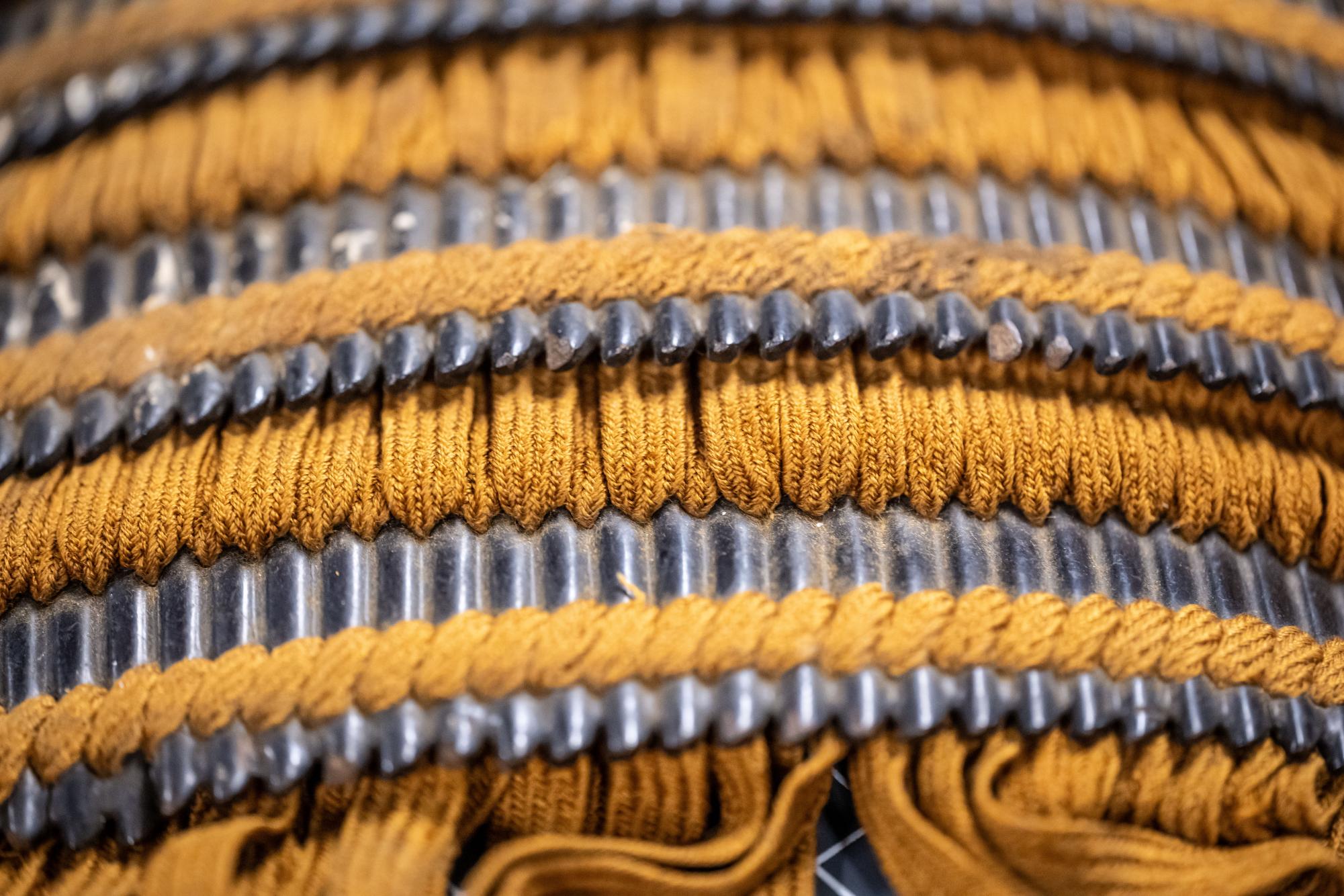
This is the story of Tokugawa Kato, a great samurai and warrior. Kato’s story is long and complex, but it begins on the east coast of Africa, during the mid-16th century, and is best told by the samurai himself.
I had lived in the coastal city of Zanzibar for the first six years of my life when I boarded a Portuguese ship for the first time. I carried boxes and boxes of gear and supplies across the ship’s deck, toward the storage area below, even though I was just a child. Despite being held against my will, I was eager to explore, to journey to a new and far place in the world. We began sailing. I wasn’t quite sure where we were going, and I became even more confused after a typhoon struck, pushing us off course.
The violent storm caused us to shipwreck. António Peixoto, António da Mota, and Francisco Zeimoto, the voyage’s leaders, were three Portuguese explorers. We had landed in this new world, what we would come to know as Tanegashima, Japan, in 1543. While it was an accident, it would lead to drastic changes in Japanese culture.
The minute the Portuguese made contact with the locals, they began exchanging resources. Most coveted was the matchlock-style firearms introduced by the Portuguese. The Japanese were fascinated and hungry for more information. The other slaves and I hung back while they talked, waiting to be told what to do.
As we waited, I began thinking. Suddenly, I realized that in this new environment, I had a chance to escape from the Portuguese sailors and into a new world. The generals stood distracted, likely planning their next move or bargaining tactic. I was still on shore, standing near the boxes of things I had brought back to land. Now was my chance. I paused, taking another look around. The area along the water was open, but just past the first row of buildings were small paths and trees, perfect for quickly disappearing.
Once the idea had struck, I didn’t take more than a few seconds pondering it. I took off through the woods, my heart pounding and pulse racing. Before I knew it, I had stumbled upon a house. The house was likely new, built in the Muromachi period. I could see through the window a tearoom and tsuke shoin, or study room, two distinctive characteristics of architecture at this time. I noticed a middle-aged man standing just outside.
His head snapped up as I approached. He seemed hesitant, mystified by me, the stranger who now stood before him. However, once I spoke, the conversation seemed to flow smoothly. He introduced himself as the local daimyo, Matsudaira Hirotada. Hirotada asked lots of questions, especially of such a young child, as he escorted me inside. They were basic at first but became more in-depth as time went on. I told Hirotada how I ended up at his home, and what I was running from, as best as I could. He seemed to understand, which wasn’t what I was expecting. Japanese samurai were known for their strong code of honor. It was even common for them to welcome hostages into their lives and teach them.
In the house, my eyes were drawn to the corner of the main room. A set of classic dō-maru armor was laid out across an old chair. The armor was in perfect condition, as if it hadn’t been worn at all. The tightly woven and brightly colored skirt followed a split apron pattern. The chest plate was simple, just strong enough to protect from a knife or sword. It was detailed, simple, and majestic all at once. I hoped that one day I might be honored with a similar set.
When the conversation seemed to slow, Hirotada paused for a moment. Hirotada’s wife, Odai no Kata, joined us inside and watched attentively. What Hirotada said next lifted a million pounds of stress off my shoulders, and any sort of jitters or anxiety seemed to leave my body.
“Would you like to stay with us? “You’re so young, and you deserve someone who will care for you,” were Hirotada’s exact words. Time flew by, and before I knew it, we were as close as I had been to my family back home in Africa.
At the time I began living with Hirotada and his wife, they had just had a newborn, Tokugawa Ieyasu. Despite the six-year age difference, we grew extraordinarily close. We played together, hung out constantly, and even did chores together. Unfortunately, just several years later, we were separated from both Hirotada and Kata and held hostage in Sumpu by a nearby clan, the Imagawa.
In accordance with the Samurai Honor Code, the clan raised us kindly, and I soon began training to be a samurai myself, as did Ieyasu just a few years behind me. The lessons combined physical exercises, historical study, poetry practice, and, most importantly, spiritual discipline. Many of the practices were influenced by Confucianism and Buddhist principles. There were seven principles of samurai education: justice, courage, benevolence, respect, honesty, honor, and loyalty. After we had finished learning about bushido, a code for being both fearless and kind, my training was complete, and I was able to don armor similar to the set that had mesmerized me so deeply many years before.
As I slid the chest plate on, I noticed some differences. This armor was known as Yokohagi Okegawa ni-mai do. It had a leather-covered iron chest plate, strong enough to protect from not only knives and swords but also firearms. I observed the medallions and how they differed from Ieyasu’s father’s. These small medalions shined a bright bronze color. The neck pad felt snug against my skin, the silk was soft and smooth, and the skirt, made from iron, leather, and wool, fit perfectly. The helmet was by far the most prestigious part of the armor set, and I felt incredibly accomplished to be honored with such an intricate piece of artwork.
I wore the armor proudly throughout my life as a samurai warrior, always keeping in mind the kindness Ieyasu’s father had shown me on that day long ago. I stuck with Ieyasu, whose friendship was as strong as ever as he transformed into a powerful leader. I stood alongside him as he unified Japan and ended years of unnecessary violence between clans, becoming one of several shoguns during the Sengoku period. As I grew old, my duties lessened, and my usage of the armor faded away. Instead of letting it sit, useless, I passed it onto the next generation of samurai, which included my young son, Shingen. I hoped it would inspire him just as it had me.
Bibliography
“1. History of Armor.” Sengoku Daimyo, Accessed 22 Sept. 2023. sengokudaimyo.com/katchu-katchuch01.
“Arrival of a Portuguese Ship (Article).” Khan Academy, Accessed 22 Sept. 2023. www.khanacademy.org/humanities/art-asia/art-japan/edo-period/a/arrival-of-a-portuguese-ship.
“Japan: Memoirs of a Secret Empire . Samurai.” PBS, Public Broadcasting Service, Accessed 22 Sept. 2023. www.pbs.org/empires/japan/enteredo_8.html.
“The Muromachi Period.” Encyclopædia Britannica, Encyclopædia Britannica, Inc., Accessed 22 Sept. 2023. www.britannica.com/art/Japanese-architecture/The-Muromachi-period.
“Tokugawa Ieyasu.” Encyclopædia Britannica, Encyclopædia Britannica, Inc., Accessed 22 Sept. 2023. www.britannica.com/biography/Tokugawa-Ieyasu.
“The ‘discoverers’ of Japan.” Welcome – 澳門特別行政區政府文化局 Instituto Cultural de Governo Da R.A.E de Macau, Accessed 22 Sept. 2023. www.icm.gov.mo/rc/viewer/20017/974.
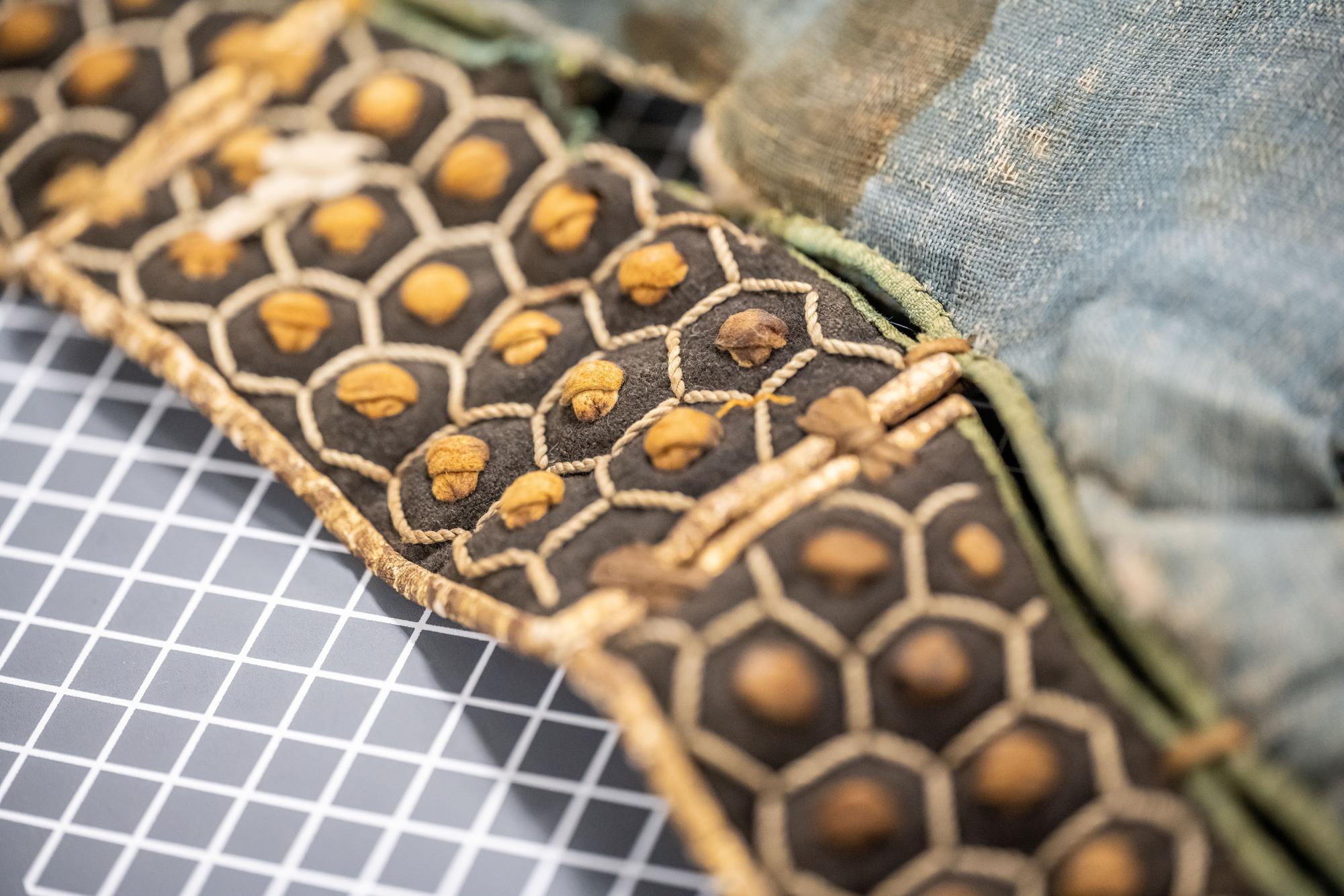
“Yamada Shinjuu Narisada,” the old craftsman sighed, “I have known who you are since before the first time you snuck into the back of my shop.” Yamada was frozen in his spot, but he felt his muscles loosen. He turned to the armor hanging on the wall behind him to hide it. “The nineteenth son of Yamada no Shingorō Nobutada of the Yamada Clan.” Gently, the old craftsman put the katana on the rack.
“My name, young Yamada, is Takayama no Kinjirō Hideyoshi. I am the second son of Takayama no Shintarō Mototoshi—though, I may have been the second son, but I never came second.” Hideyoshi sighed. “Your father,” Hideyoshi began, “has a tendency to ignore that which reminds him of his whole self, flaws and all. It is a serious weakness of his he refuses to address, and those who know it have begged him to see the truth of the matter to no avail.”
Hideyoshi looked at the nineteenth son of his childhood friend and felt his chest tighten. “Yamada, the fact of the matter is that you have your father’s best traits and a couple of his worst. It is not your fault that Nobutada cannot face his own self reflected at him without seeing his greatest weakness.” The old craftsman sighed. “Yamada Shinjuu Narisada, you are not the unwanted son. You are your father but greater, a truth that strikes at your father’s ego very harshly. Due to Nobutada’s weakness, he has refrained from interacting with you, instead instructing your eldest brother to teach you in his stead; to be blunt, your father is being a coward.”
“This armor is for you, Yamada Shinjuu Narisada. You have been wearing your brother’s old armor for far too long.” The youngest Yamada looked both young and old at the craftsman’s statements.
Watching as the young samurai bowed respectfully, taking the armor and his leave, Hideyoshi allowed his face to fall into a grimace. The armor, he felt, was not nearly enough to make a difference. It had been constructed with much care, of course. The Takayama family had been known for making high quality armor for over eight hundred years, and Takayama no Kinjirō Hideyoshi was not one to end his family’s honorable legacy. Hideyoshi sighed deeply. He had failed his friend, and his friend’s son. Hideyoshi had been the young Yamada’s genpuku sponsor for his coming-of-age ceremony, and it had not missed anyone’s attention that Yamada Shingorō Nobutada had been mysteriously absent. It was incredibly painful for Hideyoshi to see his friend display such unreasonable and dishonorable family discord for the world to see, especially in such turbulent times. The armor could not make up for the shame the young Yamada’s father had brought.
Hideyoshi reflected on the armor. It most likely would not stop a bullet like Hideyoshi had first aimed for, but it would help. The young samurai would display the flag of the Yamadas in two days’ time to rally their warriors against the Kō clan, and he would do it wearing armor that fit him well. Hideyoshi hoped that his work would bring the boy fortune.
Hideyoshi hoped to speak with his friend about this first. Nobutada had wrote him, asking to meet and discuss the southern savages and their wares, as well as Tokugawa’s most recent meeting, and so many important things that managed to pale in comparison to Nobutada’s disgraceful and unreasonable treatment of his youngest son.
The sun had finally fallen beneath the lands below, the last of the sunlight appearing on the edge of the land as a deep but visible shade of blue. With the night sky letting go of the sunlight, so too did Hideyoshi let go of his anger of the day, as he made his way to sleep the night away. Hoping, of course, that he would not feel the need to correct his friend’s errors like the boulder tries to correct the river.
***
“I have harsh words for you, my friend,” Hideyoshi said. Yamada Shingorō Nobutada looked up warily, as the pair strolled through the Yamada gardens, sakura petals falling gently around them.
“Dare I ask what they are, Hideyoshi?” His genuine tone put a bitter taste in Hideyoshi’s mouth.
“There are three. Yamada Shinjuu Narisada.” The atmosphere turned tense.
“That boy,” Nobutada began, grinding his teeth, “does not have a pinch of—”
“Do not lecture me about imagined and unbased falsehoods once again. I am not asking you to see reason anymore, for I have given up. You see nothing of your errors, Nobutada, and it will be your downfall, but I shall not let it be your youngest son’s downfall as well!” Hideyoshi spoke sharply, his words cutting and angry. “When I ask for your reason or evidence against your son, you have nothing. You are blind to yourself! But it does not matter. You will allow your son to lead your men into the final battle between us and the remainder of the Kō clan. Your other sons are unavailable, I understand?”
Yamada Shingorō Nobutada twitched, his mouth slightly hung open in surprise. “I will not let that boy lead the battle. General—”
“Once again old friend, I am not asking you.” Hideyoshi took a deep breath, the scent of Sakura blossoms gracing him. “You will be hearing of this from your other sons’ letters, from our friends Hashimoto and Natayama.”
“You brought—”
“You,” Hideyoshi interrupted, “will also hear from the generals under your command, including the one you wish to lead the battle in thirteen days’ time. Nobutada. It is high time you throw your ego away and let your youngest son, who if I might add, is a worthy member of the Yamada clan according to all your sons, have the respect he so deserves!” “You are bringing shame and discord to your family, and as your friend I cannot allow this. Please, Nobutada.” Hideyoshi fell silent, his kamishimo suddenly feeling rough against his skin.
After a long stretch of poisonous silence in the gardens of the Yamada estate, Yamada Shingorō Nobutada spoke. “Fine.”
There were no more words exchanged for the rest of the walk. The silence was cruel, but the outcome of Hideyoshi’s most uncomfortable talk with Nobutada was warm enough to uplift Hideyoshi despite the heavy silence lingering like noxious vapor. Yamada Shinjuu Narisada would lead their men into battle in thirteen days.
***
Hideyoshi smiled as he watched the estate burst with life. The celebrations in and around the Yamada estate were bustling. Hideyoshi, to his own embarrassment, felt prideful of the whole thing.
Everywhere Hideyoshi went, he could hear Yamada Shinjuu Narisada’s name being spoken with awe and respect. The tale had to have been told more than a hundred times already, and yet it wasn’t close to dying down. Takayama no Kinjirō Hideyoshi felt an embarrassing amount of vindictiveness at the young Yamada’s success, despite his father’s neglect and despite the unexpected support the Kō got, aided by the Kiyooka clan.
Even though the size of the enemy’s army doubled, Yamada Shinjuu Narisada successfully rallied their soldiers with an inspiring speech, consequently winning the battle and ending the Kō, purging them from the mountains that the Yamadas’ protected. Hideyoshi was struck from his thoughts when he noticed the star of it all walking towards him. A smile was on the young man’s face, painfully mirroring the smile of his father. And yet, the way he walked was not nearly as overly confident. In that moment, Hideyoshi was struck by how Yamada no Shinjuu Narisada truly was a better version of his father, a better version of his best friend. Takayama no Kinjirō Hideyoshi felt his heart clench at the bittersweet realization.
Finally, as the newly recognized samurai approached him, Hideyoshi bowed to the young samurai, and the young samurai bowed back.
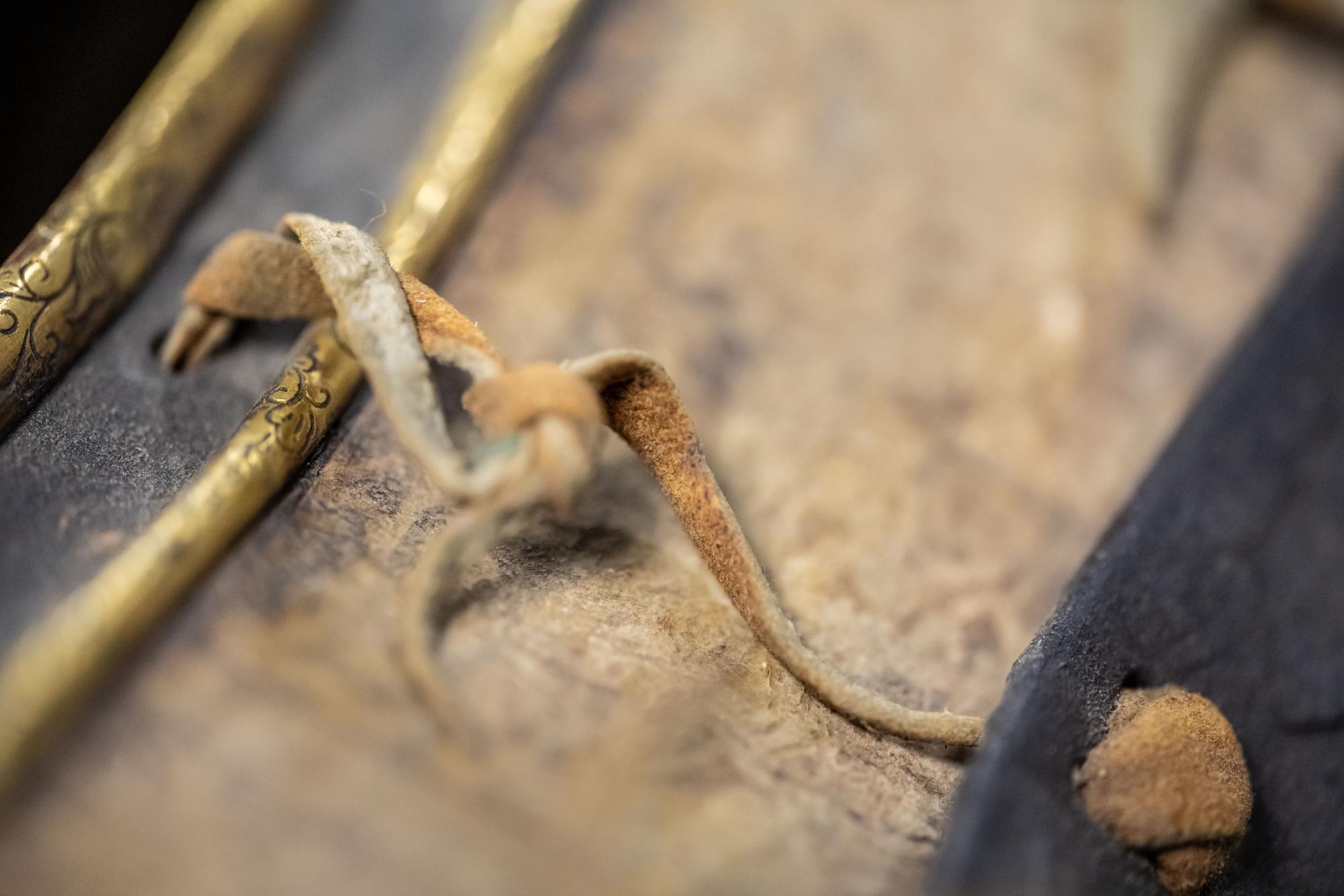
It was the smell that stuck with Kumataro, a stench of blood, mud, vomit, sweat, and rain mixed into a sludge that clung to your clothes and skin that no matter how you scrubbed, it would forever stain your soul, if not your skin. Kumataro wished for peace.
He didn’t even know why he was fighting anymore.
He was fighting in the armor of a dead man. A true warrior who did not deserve the fate he was left with, but that is the price one must face after carrying the armor’s curse—the bloody armor, with its stained collar and leather straps.
“Suzuki,” another Samurai also in the employ of the daimyo Imai called out to Kumataro, “Finish taking what you want from the dead men, we leave in five minutes.” Kumataro needed to leave Japan and go somewhere else, somewhere where the war of the south court and the north court and the daimyo and the peasants were nothing but a distant memory.
Kumataro looked out from under his helmet through the rain to the west, over the hills and green valleys painted red with the blood of dead men. Kumataro knew what he would be subjected to if he was caught deserting. Seppuku or, worse, exile.
Kumataro stoodin the rain, contemplating, gun smoke long having left the air, the rain making the gunpowder all but worthless. As if manifested out of thin air, a white steed as calm as can be sidled up to him. Kumataro stared into the blue eyes of the stallion and felt compelled to get on and ride until he met the sea.
If not now…then when? Those thoughts ran circles around Kumataro’s mind, banging up against his helmet. Kumataro heardone of the others from the group that served Daimyo Imai call out for him, looking for him. This was it. This was his time to act, to turn away from this and do his duty under the Imai family as he pledged… or to run and risk death.
Kumataro climbed atop the white stallion, and spurred him away, toward the west. Plans raced through Kumataro’s head at the cadence of the hoof beats on muddy ground. The stallion was swift-footed and carried Kumataro’s weight with ease and grace. They rgalloped, chasing the rain and wind as if they, too, were nothing but rain and wind personified.
They rested in the wilderness the first night. Kumataro was nervous, worried his old comrades were pursuing them from behind, but his horse was exhausted, and he had not taken a moment since the battle many hours before. The night was quiet in the clearing Kumataro chose for camp. The sleep was the first true rest Kumataro had known since becoming a samurai, since the first man he killed; Yasuke.
Kumataro could still remember the mighty warrior’s face as Yasuke fell to the ground as he, Kumataro, a young man so full of rage beat him with a tree branch. It was not a fair fight, if it was, Kumataro was sure he would not be upright and breathing today. Decapitating Kumataro was awful. What was worse was the joy Kumataro found in the act. How could Kumataro have been so foolish?
Privately and to himself, Kumataro swore he would find a way to make it up to Yasuke, to atone for the wrong he brought. Perhaps then the armor’s curse would spare him from a younger man’s rage. It was a foolish thought.
The sunrise the next day revealed no pursers and Kumataro and his stallion pressed on. It took over a week to reach the shore, and Kumataro truly couldn’t have been more relieved when he made it to the ocean.
But even in the city of storms, full of tough fishermen and hardworking folk who could hold their own, they were incredibly wary of Kumataro, most not even speaking to one in the garb of a samurai. The only man who talked to him was the man to whom Kumataro sold the stallion that carried him all this way. Kumataro was sad to see the horse go, but it had to be done.
Kumataro, having no other options, started interrogating the village people for information and, in the annoyed and terrified ramblings of an old woman, he found his salvation. A boat, smuggling people who had the money, to China, Kumataro demanded directions and found the man taking people away.
The man, Yamada, denied he was smuggling people to China until Kumataro showed him the money he was able to get for his stallion. Yamada was a lot more willing to work with him, though Kumataro suspected that Yamada was upcharging him. Still, a chance to get out of the country was too good to pass up.
The ship left in three days and for those three days, Kumataro spent his time cleaning the armor. The blood stains of those poor souls who came before Kumataro did not come out. The silk and leather seemed to cling to the blood. Kumataro had spent many hours trying to get the same stains out to no avail. These three days were the quietest, and best days, he had known since childhood. The all-consuming rage he had felt since early adolescence had dispersed, leaving nothing but empty regret and exhaustion. Kumararo relaxed and disputed the regret. In a few short days, he would be in China, free of the war plaguing Japan.
Getting to the ship required taking a small vessel three clicks out to a Dutch trade ship that was going to China for trading purposes. Money was exchanged, arguments ensued, and shots fire. Kumataro ended up stepping in, forcing Yamada to give all the money to the Dutchmen, pocketing nothing for himself. Kumataro relished the sour look on the mean old man’s face as he rowed back. This time with no customers to row the boat for him.
The ride to the Chinese shores blew good fortune Kumataro’s way. The Dutchmen were happy at Kumataro’s quick defense of their ship, and the extra cash that ended up in their pocket didn’t hurt either. Kumataro was treated like a king, or at least better than the other people being smuggled into the country. He ate and drank with the Dutchmen. Their food was strange and their liquor stranger still, not that Kumataro minded too much. Food was food, and he was happy to not be fed scraps of rice like the others.
Truth be told, Kumataro couldn’t tell how long he was on that boat. It was a blur of feasting, liquor, tobacco, and sometimes something stronger. It didn’t make tracking time any easier when the sailors never seemed to tire and worked all day only to party right after. All Kumataro knew was that two days away from shore, the liquor was put away and the hangover the lot of them had right after was not very good for morale.
With that, Kumataro’s time on the Dutchman’s ship came to an end with tearful goodbyes and promises to see one another again they left for the markets.
Kumataro set out for the fields to find a place to rest. On the outskirts of town, he found a tall, shaded tree to protect him from the sun. He sat down and leaned against it, closing his eyes. Finally, Kumataro was able to relax.
That was probably why he didn’t see her coming up behind him with a sword.
The man’s head rolled off his shoulders, but no calm was felt. The armor…it whispered to her; demanded she take it. Lu did so as if in a trance, anger making her stronger as she tore the man from his calm shell armor and put it on herself. She contemplated where to go next, perhaps to serve the emperor.
The cycle continued, and the armor was content.
Your donation will support the student journalists of Norwich University. Your contribution will allow us to purchase equipment and cover our annual website hosting costs.
